
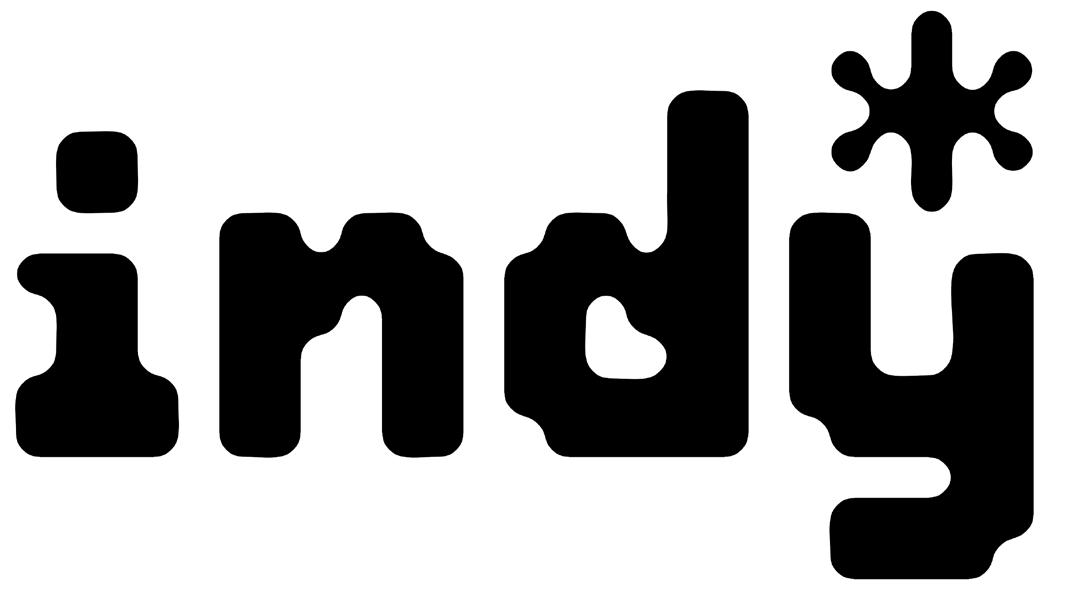



Lately, all I do is think about my mother and cry into the acrylic-woolblend of my latest crochet project. She tells me to come home—“For Thanksgiving?” I say. “Across the country for four days? Not worth it,” choking back my voice cracks. “Are you crying?” My sister asks. “No,” I whisper. “Definitely, definitely not.”
When I watched Everything, Everywhere, All at Once (Kwan & Scheinert, 2022) for the first time last summer with my sister and my mother, I was also holding my breath trying to keep the tears at bay. I was hysterical, but only on the inside. I couldn’t let her see my reaction. My mother sat at my back, but I swore I heard her sniffling. Crescendoing. What was she thinking? Did she see herself in Evelyn? Did she see me in Joy? Then the credits rolled, and she said in a thick voice: “I don’t really like it. It’s not true to Chinese values. Or imagination. Chinese people don’t think about the multiverse.”
But Mother, I wanted to say. Mama. Imagine the other worlds. Imagine space contracting. Imagine my success, imagine yours. Imagine this cro chet cardigan that I complete. Imagine we cry together? Shouldn’t we stay together? Shouldn’t we change less? Should I come home? -JW

MANAGING EDITORS Corinne Leong Sacha Sloan Jane Wang
WEEK IN REVIEW Masha Breeze Nora Mathews
ARTS Cecilia Barron Anabelle Johnston Lola Simon
EPHEMERA Chloe Chen Ayça Ülgen
Zachary Braner Ryan Chuang Jenna Cooley
Madeline Canfield Tierra Sherlock
METRO Jack Doughty Nélari Figueroa Torres Rose Houglet Nicholas Miller
SCIENCE + TECH Justin Scheer Ella Spungen Katherine Xiong
WORLD Priyanka Mahat Alissa Simon
X Lucia Kan-Sperling Seoyoung Kim Maxime Pitchon
DEAR INDY Annie Stein
BULLETIN BOARD Sofia Barnett Kayla Morrison
SENIOR EDITORS Alisa Caira Sage Jennings Anabelle Johnston Deb Marini Isaac McKenna Peder Schaefer
STAFF WRITERS
Hanna Aboueid
Madeleine Adriance Maru Attwood
Graciela Batista Kian Braulik Mark Buckley Swetabh Changkakoti Laura David Emma Eaton
Danielle Emerson Mariana Fajnzylber Keelin Gaughan Sarah Goldman Jonathan Green Faith Griffiths Eric Guo Charlotte Haq Anushka Kataruka Roza Kavak Nicole Konecke Cameron Leo Kara McAndrew Morgan McCordick Sarah McGrath Charlie Medeiros Alex Purdy Callie Rabinovitz Kolya Shields Alex Valenti Julia Vaz Kathy/Siqi Wang Justin Woo
COPY CHIEF Addie Allen
COPY EDITORS / FACT-CHECKERS
Ava Bradley Qiaoying Chen Dun Jian Chin Klara Davidson-Schmich Eleanor Dushin Mack Ford Zoey Grant Aidan Harbison Doren Hsiao-Wecksler Rahmla Jones Jasmine Li Rebecca Martin-Welp Everest Maya-Tudor Eleanor Peters Angelina Rios-Galindo Grace Samaha Shravya Sompalli Jean Wanlass
Klara Davidson-Schmich Britney De Leon Ayça Ülgen
COVER
Soeun Bae
Anna Brinkhuis Sam Stewart
Brianna Cheng Ri Choi
Addie Clark
Amy/Youjin Lim Ash Ma
Jaesun Myung Enya Pan Tanya Qu Jeffrey Tao Floria Tsui Anna Wang
EDITORS
Sage Jennings Jo Ouyang
Sylvie Bartusek Noah Bassman
Ashley Castañeda Claire Chasse Julia Cheng Nicholas Edwards
Lillyanne Fisher Sophie Foulkes Haimeng Ge Elisa Kim
Joshua Koolik Lucy Lebowitz Sarosh Nadeem Hannah Park Sophia Patti Izzy Roth-Dishy Livia Weiner
Iris Wright Jane Zhou Kelly Zhou
Anabelle Johnston Bilal Memon
Rini Singhi Jean Wanlass
MVP Ash Ma
The College Hill Independent is printed by TCI in Seekonk, MA
The CollegeHillIndependent is a Providence-based publication written, illustrated, designed, and edited by students from Brown University and the Rhode Island School of Design. Our paper is distributed throughout the East Side, Downtown, and online. The Indy also functions as an open, leftist, consciousness-raising workshop for writers and artists, and from this collaborative space we publish 20 pages of politically-engaged and thoughtful content once a week. We want to create work that is generative for and accountable to the Providence community—a commitment that needs consistent and persistent attention.
While the Indy is predominantly financed by Brown, we independently fundraise to support a stipend program to compensate staff who need financial support, which the University refuses to provide. Beyond making both the spaces we occupy and the creation process more accessible, we must also work to make our writing legible and relevant to our readers.
The Indy strives to disrupt dominant narratives of power. We reject content that perpetuates homophobia, transphobia, xenophobia, misogyny, ableism and/or classism. We aim to produce work that is abolitionist, anti-racist, anti-capitalist, and anti-imperialist, and we want to generate spaces for radical thought, care, and futures. Though these lists are not exhaustive, we challenge each other to be intentional and selfcritical within and beyond the workshop setting, and to find beauty and sustenance in creating and working together.
Halloween is in the air, and the famous ideas known as ‘costumes’ are the talk of the town. But not everyone has time to plan them! We know our read ers, and we know the nonstop cosmopolitan lifestyles they lead: you might have been busy having good intentions or drinking a glass of water. Anyway, we have you covered—with these costumes, you’ll be the belle of Pumpkin Hall:
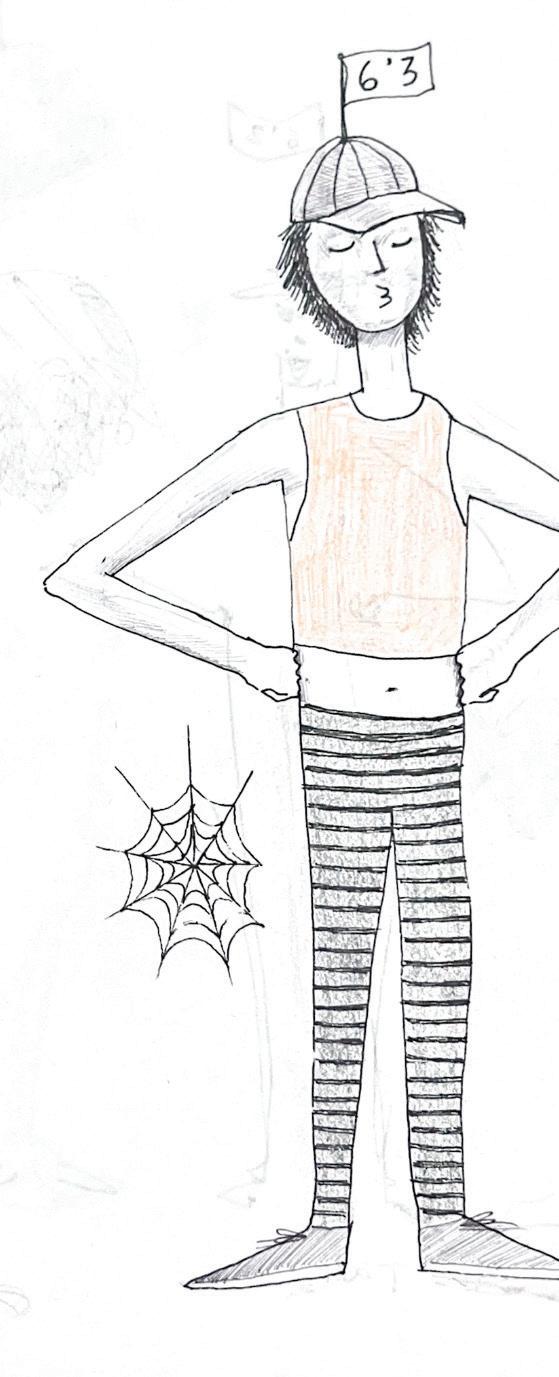
Why be a shrimp on the scariest day of your life when instead you could just put on some off-puttingly gorgeous 20-inch heels and be the tallest ghoul of them all?? Why would you do that? Be tall!

John Waters says don’t eff anyone who doesn’t own any books…to that I say: if I dated nerds, I would never have scammed enough venture capitalists to start my company that uses uneth ical data extraction to give people ideas for how to caption Instagram posts! But on a day like Halloween, it can be fun to ironically inhabit the mysterious and twisted mind of someone who values something like books (which we have a very specific and valid reason for hating that our ongoing litigation with the National Librarians’ Association does not allow us to elaborate on at this time). Let your fellow godless Hallow’s Eve celebrators know you’re flirting with the ideas contained in a dusty tome by wearing a pair of $11 pat terned ‘joke’ socks under neath a normal outfit! Try wearing a shirt and pants and regular shoes or maybe a jacket if you’re cold.
3. Girl who is Sick and Evil and Can’t Be Put in A Box
Try being a girl whose mind is sooo dark, whose psyche is sooo impene trable, who thinks about things like skulls because she’s just into effed up crap like that…this is a girl who doesn’t clean her room (she has a loose ribbon on her floor), a girl who kind of doesn’t care about the ‘norms’ of society (there’s a computer cord on her bed). This is a girl who lives her life in a way that someone like you or me could barely recognize (she wore leg warmers with a skirt last month)...this costume is only for people who are really ready to venture into a deeply disturbing psychic landscape.
4. Male Pattern Baldness

There’s nothing wrong with being bald. But there is something wrong with wearing an immediately recognizable costume that builds community with other members of your niche microculture! Reject common ground and be the concept of male pattern baldness. I don’t know, wear plaid and shave your head. Now there’s an idea you don’t see every day. Earlier today I dropped a salad on the ground and I didn’t even care. This is the kind of reckless and carefree lifestyle that leads people like me to come up with ideas like this.
5. Sexy Medieval Disease
Ever wanted to experiment with showing a little skin and basing medical science off of the color of your pee? Like pink eye, pasta dishes, and some haircuts, the medieval times are innately sexual. Show your peers that you can watch the kissing parts of movies without acting weird by being an afflicted serf or a blighted hermit who can, like, get it.
6. Boymoding!

Going home for Halloween? Tired of being an agoraphobic trans woman who has to constant ly perform femininity perfectly or else suffer social shunning, and potentially physical harm? Don’t want to get a milkshake thrown at you this year at Derek Freep’s annual Halloween Scary Monster Bashapalooza? Just put on a big sweatshirt, pull your hair back into a bun, and suppress your fundamental identity and place in the world for 20 minutes. Who’s that? It’s Der ek’s mom who came for some reason, walking your way and making intense eye contact! She’s gonna tell you that you look handsome, so how about you just leave right now and go hang out with only other trans women forever because they’re the only people who don’t infantilize, fetishize, or villainize you! Now that’s what I call spoopy xD
7. Joker Costume
If you’re in your “Joker Era,” why not go just full cray-cray? Put on some clown makeup and spend the whole night doing a long-form im prov bit as Heath Ledger’s Joker, no matter how many times your friends tell you to stop. If they love you, they’ll accept your bold choices and inability to tell when you’ve gone too far.
8. Us!
One’s a loser, three’s a crowd, but two is juuuust right. So this Scary Month of Ghostto ber, why not shake things up by doing a cou ples costume with your landlord, coworker, or frenemy, and making that costume everyone’s favorite gournalists (girl journalists)? It’s real easy to do a Masha and Nora costume—for Masha, just put on a modest sweater, a can-do attitude, and carry around a super hilarious coffee mug that says “Don’t talk to me until I’ve had my COVFEFE!” For Nora, get clip-on bangs, flawless plastic surgery, a crop top that says “I’m with stupid,” and fill your arms with books that you drop constantly, waiting for someone else to reach down to pick them up for you so that when you also reach down, your hands touch. If you’re a pet owner, you can do a fun version of this where you put two ferrets in wigs!

Published anonymously to protect the identity of the author’s parents
It’s 10 p.m. on a Saturday at my house back in Connecticut. My friends and I are smushed on a couch in the middle of the summer, a dusty window fan providing white noise as we scour Netflix for the worst teen movie we can find. We’re scrolling through gold: 30-year-olds playing deeply troubled sophomores in high school, a love triangle including two men who look exactly the same, and a woman who dresses like she walked blindfolded into a Forever 21 in 2016. We bounce between The Kissing Booth and 10 Things I Hate About You (not even a bad movie, it’s just that all the characters are so easy to make fun of), but we ultimately decide on To All the Boys I’ve Loved Before. Within the first minute, the main character establishes that her mother is dead.
“Of course her mom is dead,” I say, throwing my arms up in defeat.
“The mom is always dead,” my friend responds.
For the rest of the movie, I think about all the stories I know that feature main characters whose mothers have died. The Kissing Booth fits into this category; so do Clueless, most Disney movies, Frankenstein, and To Kill a Mockingbird. All these dead mothers function as plot devices— they further the development of the protagonist by giving them a bit of trauma so the viewer doesn’t think they’re drowning in privilege. The writers rarely give mothers any character traits aside from being caring and maternal. A mother is not a person. She’s a swift mention in a conversation in which the protagonist says, “I miss Mom,” and their father says, “I miss her too,” *pause* “I miss her every day.” She’s missed for what she provided, not remembered for who she was.
Children in movies bring up their dead mothers when they’re looking for the support of a mother figure, not because they’re grieving over a human soul. Vague characterization carves them into outlines of mothers as opposed to the colorful personalities of the on-screen characters, often just a pair of shoes for a female protagonist to fill. In To All the Boys I’ve Loved Before, the main character’s older sister, Margot, is portrayed as the responsible replacement for their mother. Her mother’s death is a catalyst for her and the main character’s development and makes the audience sympathetic to the father. Ultimately, the mother is a tool used by the living characters.
female friends, we’re talking about our horrible experiences with men.
“When I broke up with him he started crying. I had to think of my mom dying so I could cry,” she tells me.
I laugh; I think about my mom dying when I need to cry, too. Is it fair to use my mom like this in my own life? I think. Is my mom a plot device to me? I think.
In a discussion of dead mothers in movies, it was easy to second-guess myself, to tell myself, “O.K., but it’s just a movie. Obviously she isn’t a fully fleshed-out human being. She’s a character.” In real life, on the other hand, I have to face the fact that I don’t see my mother as a person head-on.
This isn’t the sort of cogni tive dissonance I’m used to. I watch video essays on the misog ynistic ideals that underscore the manic pixie dream girl trope. I read bell hooks. I talk to my friends about how the boys in high school were shocked to discover that we had beliefs and hobbies.
But I hit a wall when I apply this thinking to my own mother. There seems to be a differ ence between me going out with friends and her getting lunch with her friends. I believe there to be an air of fiction about her going to the marina to watch the sparrow murmuration, or going to the lake to paddleboard, or going to the backyard to read. It’s not the same as when I knit or go to the beach or put stickers in my journal. It’s not the same as when my father spends weeks at a time away from home, spends full days sailing with friends, and spends nights drinking with them. I struggle to see my mother as my own blood. I perceive us as occupying different spaces of the world. To me, her space is taking Zoom calls for her job at the end of the dining table. It’s going to the grocery store and cooking pasta. It’s cleaning when we have guests over. Sure, my father spends weeks at a time away from home, spends full days sailing with friends, and spends nights drinking with them, but I think of it differently with him.
I can’t tell if this is pure selfishness or pure misogyny or a mix of it all. As hard as I try, I can’t fully comprehend that my mother has a life of her own. Shouldn’t she be completely devoted to motherhood? To serving me?
of the men made no spontaneous mention of doing something for a child—like brushing hair or fixing a meal.” The study concluded that whether or not a woman makes more than her husband, she is less likely to have leisure time, likely as a result of patriarchal standards that wrongfully assume women are inherently more caring than men.
Hochschild wrote The Second Shift in 1989, but its themes are still applicable to modern-day society and media. I knew this when I read Hochschild’s theory in my junior year of high school, but I didn’t consider the impact that it had on my own view of my mother. Sure, I felt bad for her and thought my father should pitch in more, but I never reflected on the structures that dominated my thinking.
It’s 10 p.m. on a Wednesday in my friend’s dorm room. We’re supposed to be studying. I’m surrounded by the warm scent of her plug-in air freshener and the comfort of her mattress topper. She asks me if I want to have kids. I say, “Maybe,” but I know that I really don’t.
It’s 10 p.m. on a Friday at Jo’s. I’m sitting across from my friend eating a salad and fries. The air is dry, but I can feel grease accumulating on my hair and skin. As with most late nights spent with
In The Second Shift: Working Parents and the Revolution at Home, Arlie Russell Hochschild explains that the women’s liberation movement, while allowing women to enter the labor force and make their own money, did not free women from household responsibilities. In a study of heterosexual couples, Hochschild and Anne Machung found that “3 percent of wives but 46 percent of husbands didn’t mention the house at all in their spontaneous description of a ‘typical day.’ Three percent of the women and 31 percent
Setting aside all my beliefs about toddlers being gross and my fears of having a really annoying kid, I don’t want to be a mother because I know that if a woman is a mother, she will likely never truly return to the woman she was before. Once I become a mother, people will start to see my interests, hobbies, and ambitions as add-ons: they’re nice to have, but not critical to living a fulfilling life. They’ll think that having a family is enough for me and that the sacrifice of what I loved before is worth it, but the truth is that I don’t think it is enough. I want to be fleshed out. I want to be whole and human and
full. I want to be happy, not just content. I want to soak in all the sunny and muddy and gross and amazing particles of this world, and maybe that isn’t possible if I start a family.
Loss of innocence is usually part of a char acter’s childhood. Coming-of-age movies like Ladybird and The Breakfast Club tell the stories of kids who learn that the world isn’t as perfect as they think it is, but maybe the real loss of inno cence happens when we aren’t looking. Maybe, for mothers, it happens when they realize that they have to give up parts of themselves to help their family.
It’s typical for high school English classes to talk about Scout’s coming-of-age in To Kill a Mockingbird, but students rarely discuss her mother (who died when Scout was a baby) and for good reason: the novel mentions her only in passing. In one of the few mentions of Scout’s mother, a woman tells Scout, “A love lier lady than [her] mother never lived … and it was heartbreaking the way Atticus Finch let her children run wild.” Her mother is only ever referenced when discussing how she served the family. I know she isn’t real, but my mind wanders, and I can’t help but think of who her character could’ve been if she were alive. What did she need to give up? Who could she have been if she didn’t have children? Who was she?
I attach myself to these characters who get nothing more than a paragraph in the actual
story because I see my own mother in them. I wonder who my mother would be in my own story. I wouldn’t kill her off, but I wouldn’t know how to write her in as smoothly as I could with any other woman I know. I’ve accidentally created a perception of her that’s like Scout’s mother: underdeveloped, left high and dry in a self-centered story.
I ask my friend, “Do you want kids?” and she says she does. I tell her she’d be a good mom, but what does that even mean to me? Do I say that because I think she’s a kind, giving, caring soul who wouldn’t traumatize a child, or do I say it because I know she’s so kind, giving, and caring that she’d have no trouble setting the rest of her life aside? If it’s the latter, do I automatically expect that of her? I assume that every mother is like my own. I assume that they’ll quit the things they love because that’s what I’ve seen in my own life and in movies, and it’s been the standard in heterosexual nuclear families for decades.
I hesitate to say that I won’t have children at all, though. There’s a part of me that truly believes I’ll have failed if I don’t start a fami ly—I’ll be nothing if I’m not a mother.
All women eventually become someone who chooses to have children or someone who chooses not to have children. At the end of the day, is there really such a big difference between flat mothers from books and movies and the
forgotten women who don’t raise the next gener ation? I can either be a plot device or be left out of the story entirely.
It’s 10 p.m. on a Tuesday in the basement of the SciLi. I take a break from rewatching a lecture to take off my headphones and stretch. I can hear people talking and laughing in the neighboring conference room. I realize that I forgot to call my mom again. I feel bad, but not just because I forgot. I feel bad because I recognize that it’s selfish to think I’m all she has to occupy herself with
ANONYMOUS B’2X needs to go to bed earlier.
stagehandled me for a couple years, times for which I miss Joseph from high school. It upsets me that, on the page, he probably seems like kind of a joke.
Sometimes when I listen to Stereolab, I wonder what Joseph from high school would think of me.
Joseph and I took refuge in two of the same spaces: the improv team and our history teacher, Coyne’s, classroom at lunch. Joseph wore a black tracksuit and a red beret every day, and, if you were lucky, you’d get to see a gray undershirt if it was particularly hot outside.
My best friend Will already knew Joseph from a summer trip, so he smoothed over our introduction. On that trip to central Europe, Will and Joseph shared their first kisses in front of the mural My God, Help Me to Survive This Deadly Love, which depicts East German Chairman Erich Honecker and Soviet Chairman Leonid Brezhnev kissing. Joseph was a self-described communist, even petitioning our history teacher for space to host a Dialectical Materialism club every Thursday.
Mr. Coyne liked Joseph because I think Joseph reflected a portrait of Coyne’s teen age-year-old self. A whip-smart boy with one comfort outfit and a commitment to roleplay radicalism. But “roleplay” feels like it under mines his genuine authenticity: Joseph spoke Polish and knew what Gramsci meant, and, while we never got very close, I revered him for his rawness, brazenness, and consistency. Of course, in improv he killed me with a shovel, confronted me at a pinball competition, and otherwise
With Joseph on my mind, about a month ago, I went to see avant-pop1 band Stereolab in Boston, and, to my disappointment, they didn’t play the song “Ping Pong.” “Ping Pong,” off the 1994 album Mars Audiac Quintet, got the band branded “Marxist pop”—a label that they resent. As Stereolab synth player Lætitia Sadier put it in 2015, “Ping Pong” shouts at “the cycle of destruction within the capitalist cycle,” more specifically how economic crises now appear everyday and perpetual, how neoliberal politics tout an endless mantra of “building back.” “Since I was born, it’s been la crise économique” Sadier proclaims.
A bunch of Stereolab lyrics follow this sort of conscious bent. “The Free Design,” for instance, laments the infinite cycle of extraction and labor that constitutes commodification with lyrics like “the request is here ready to resurrect / What else can we do but recover the project / Our earthly design can be so detached / What crushes our desire not to be trapped?”2
Within the context of Stereolab’s style, however, these chants feel less like calls to action than they do muffly school announce ments or television commercials. Boot up “Brakhage,” a track that begins with static, as if guitarist Tim Gane and Lætitia can’t tune in to the proper frequency. Once its hooky loop
kicks in, “Brakhage” touts a loungy vibraphone, two-chords on the Farfisa organ, and an elec tronic menagerie between endlessly repeating lyrics: “We need so damn many things / To keep our lives going.” With such poetics atop a synth rhythm and submerged vocals, “Brakhage” gets to feel like background noise, its individual sections indistinguishable from each other. Lætitia sings like a lone fanatic amidst easy beats and casts us as not amidst revolution but instead restless at the shopping mall.
Maybe that’s why Stereolab makes me think of Joseph. They and he are both imitators, one a bald-faced Soviet, the other quietly screaming from behind synths, imitating acoustic pianos. Whatever the approach, each aesthetic points to contemporary Marxism as hanging on only by the thread of pastiche: imitation, remix, parody.3
In his 1993 book Spectres of Marx, Jacques Derrida coined his “hauntologie,” a portmanteau that smashes together “haunt” and “ontology.”
Derrida speaks of the fall of the Soviet Union as ushering in an era in which post-capitalist futu rity became, finally, so unreachable as to oblit erate narratives of linear modernity. For Derrida, Marx becomes a specter to the contemporary. His global iconicity now a bygone role, it is only through his silhouette in collective memory that Marx comes up in popular discourse and media.
Under a musicological framework, theo rist Mark Fisher cites electronic music artists like Burial and The Caretaker as examples of hauntological style. The artists boast samples
from ’30s and ’40s pop and experiment with old technologies like vinyl screeches to evoke an uncanny out-of-jointness with the past. Through reappropriation, they implicitly raise a forgotten collective memory from the 20th century. It’s easy to see why this framework caught a draft in the ’90s. After all, what’s the 20th century but a slowly accumulating pile of things, the epoch in which things ancient and modern became avail able at all times for our gaze or our consumption, respectively, in the museum or at the mall.
Part of what media studies scholar Ariella Azoulay terms the “appreciative gaze” calls attention to museums specifically for how they at once balloon memory while also washing over legacies of colonial theft. Polite spaces facilitate our imposed charge to mold into storehouses both vast and myopic, ourselves like black-hole inheritors to colonial modernity. Indeed, to relegate objects to their capacity for haunting suggests that those specters will slowly fade out. But the burying of a massive concept like Marxism constitutes another move, one not just political but stylistic. Stereolab itself proves that for radicalism to hold any place in the zeitgeist, it must read like a joke.
attention to their own gendered theatrics. Those theatrics remain inextricably tied to Gane and Sadier’s romantic history.
At the Stereolab concert, I found it amusing that Gane and Sadier stood at opposite ends of the stage from each other, didn’t introduce them selves nor the band, and only acknowledged one another’s presence in brief hand gestures meant to fix technical issues. Raise that amp. Quiet down. The pair separated in 2002 after a 17-yearlong relationship, and, while they co-conduct interviews, their attitude toward one another remains “stiff and polite,” according to Guardian music interviewer Ben Thomas. Their tension comes out sonically, most evident on tracks like “Pack Yr Romantic Mind” or “Refractions in the Plastic Pulse.” On the former, Lætitia’s synthy drips get interrupted by Gane’s solo gritty strum ming, while on the latter, she demonstrates her pure dominance over the ever-moldable Moog. It’s Lætitia who leads us through minimal or noisy soundscapes on “Refractions,” as it’s her in the lead, her the object of fandom, her in the foreground.
While Stereolab isn’t funny per se, their style’s all pastiche, specifically a riff on lounge and ’60s pop music. “Miss Modular” repeats a two-chord loop that appropriates a Latin pop acoustic guitar ahead of motown background vocals. “Pack Yr Romantic Mind” sets a lazy, tinny drum against short interludes from Gane’s noisy guitar. The latter reminds Pitchfork reviewer Josephine Livingstone of her old records reverberating around a “teenage bedroom.” It’s in this multi chromatic fusion of refashioned tropes that Gane and Sadier muffle their poems. Whether those lyrics wax philosophical about Sadier’s passion for theory4 or drip with desire, the words always remain just slightly below the surface, made less legible by how Stereolab straddles English and French. Their political bent drowns beneath plastic pop.
Rather than suggest that there exists a ‘tension’ between Stereolab’s nostalgic sound and their Marxist invocations, or an aesthetics of pure haunting, I like to think Stereolab suggests that such political background noise always pervaded and still pervades the now-imitated acoustic pianos from the 1960s and the Moogs of the current era. He was here. He’s still here, and, like clockwork, he’ll come back. And, “it’s alright, / ‘cause the historical pattern has shown / How the economical cycle tends to revolve,” isn’t it?
Critical theorist Roshanak Kheshti dubs Lætitia Sadier “Synth goddess.” She saw Stereolab in concert in 1995, during their meteoric rise. Throughout their career, Lætitia’s cool, stoic on-stage demeanor in contrast to Gane’s timidity has only enhanced her mystical flair. I recently saw Stereolab in concert, and any fawning over the band sought Lætitia as its object: “Lætitia, je t’aime,” they cried. It’s impos sible to conceive that Stereolab makes a contri bution to postmodernist aesthetics without
According to her theoretical frameworks in Wendy Carlos’s Switched-on Bach, Kheshti might label Sadier’s performance as an articulation of synthgender aesthetics. Synthgender runs adjacent to the ’80s feminist framework of the cyborg but more specifically describes a fusion of female musician and machine, such that the line between each blurs. I see each attribute—femi ninity and technicity—as perpetually mediating one another. Sadier’s contrast to Gane’s male lead guitarist role only appears more punctuated for how her synth envelops the audience and how they reciprocate adoration for her with their je t’aimes. Gane, likewise, seems masculine only in how his guitar angstily interrupts Lætitia like a petulant boy.
Despite her implied position as leader, though, the female cyborg doesn’t ‘win out’ within this gendered dynamic. Rather, its ever-presence suggests an underlying tension between the organic and the informatic, upon which Stereolab carries the background noise of

the 20th century.
In a 2015 interview with Red Bull Music Academy, Sadier likened Stereolab to a produc tion line that constantly “[churned] out” sometimes dozens of tracks in a day. Stereolab knows their labor constitutes something radi cally different from Marx’s factory worker. On an atomic level they’re refashioning waves over particles: noise not heat.5 As such, they also don’t pretend to promise potentialities for a utopic future. Rather than revolutionary poten tial carried on the back of the female synthborg, Stereolab preserves the present in amber. That amber is the quintessential stuff of modernity: those cycles of economic crises sung in their lyrics. Perhaps a theoretical turn back toward materialism explains why Stereolab’s return from hiatus in 2019 doesn’t feel at all inappro priate. If anything, the 2010s demonstrated cyberspace’s inhospitality to left-wing political organization and ‘liberating’ methods of digital self-making. Representations of a bright, digital future increasingly appear apprehensive, only accelerated by how the COVID-19 pandemic hyper-focused a western gaze on the screen, ‘at-home’ work and education. Stereolab sits and stirs us in our condition without pretending there is a cyborgian goddess on the other side. It is fitting, then, that when asked to answer why they came off hiatus, Sadier interrupted Gane to simply say, “for the money.”
Joseph and Will’s fraternal kiss is art. A boyish joke on a mural staged in front of the mural, they’re clearly poking fun at Honecker and Brezhnev. At the same time, last I checked, both boys still use the Berlin picture for their respective ‘first kiss’ stories. Maybe it’s just the constructed compulsory nature of ‘first time’ narratives that makes that memory seem precious (even as an observer), but the gaze that makes us ‘save ourselves’ for some truly special occasion still lends some wholesome authenticity to that smooch. In so doing, they let pastiche bleed into reality.
Contrary to contemporary turns in media that attempt to escape conflict between simu lacra and materiality, Stereolab lets the colors bleed and sees simulacral diffusion as rife with opportunities to summon specters. They’re not metafictive nor metamusical; they don’t need to get on the surface of an issue so brazenly. Nor do they purport to lyrically dig in, to psychoanalyze, to penetrate and articulate the modern condi tion better than the activist. They wear a kind of punchy irrelevance on their sleeve. As such, I’m here for Joseph, a likewise discarded boy whose Dialectical Materialism club fair table saw no attendance. Let me take you to another concert.
KIAN BRAULIK B’24 was actually discussing modern-day Marxism in America, which is not what I would have deemed a “come and get it” sort of conversation.
This interview was edited for grammar and clarity.
Ifirst read The Idiot by Elif Batuman in 2019 as Brown’s assigned reading for all incoming freshmen. The novel focuses on Selin, a Turkish 18-year-old of divorced parents who is about to begin college at Harvard in the ’90s—a biography similar to Batuman’s own. In it, she takes a number of linguistic classes, makes new friends, and falls into a romantic email corre spondence with a senior in her Russian class. An avid reader and advice-seeker, Selin both leads herself and is led through Harvard, Hungary, and finally Turkey. I remember that when I first read The Idiot, I thought Selin seemed smart; that Ivan, her older love interest, seemed like an asshole; and that none of those things would happen to me.
This summer—the last summer of college for those who matriculated to Brown in 2019— Batuman published Either/Or, an account of Selin’s sophomore year. Ivan has graduated, Selin has matured, but the essential question remains: how are we supposed to be doing all
the end of the summer after long excursions far from Massachusetts—and cried into my compli mentary pillow. Why must experiences be so universal?
Batuman graciously talked to me about these books over Zoom earlier this month. I wanted to discuss what it meant for a book as creative as her own to be assigned to a bunch of anxious, homesick, not-yet-critically-trained teenagers.
I also had a selfish reason for this interview. Either/Or informed, and exaggerated, a mini crisis in my own life: I had been feeling quite stuck. Batuman’s books felt like a way out of my stuckness, a deliverance of a sort, but to where?
I didn’t want to ask Batuman for advice—for, as you’ll see, she has strong opinions about advicegiving—but, really, I wanted to ask Batuman for advice. She was kind enough to give me some.
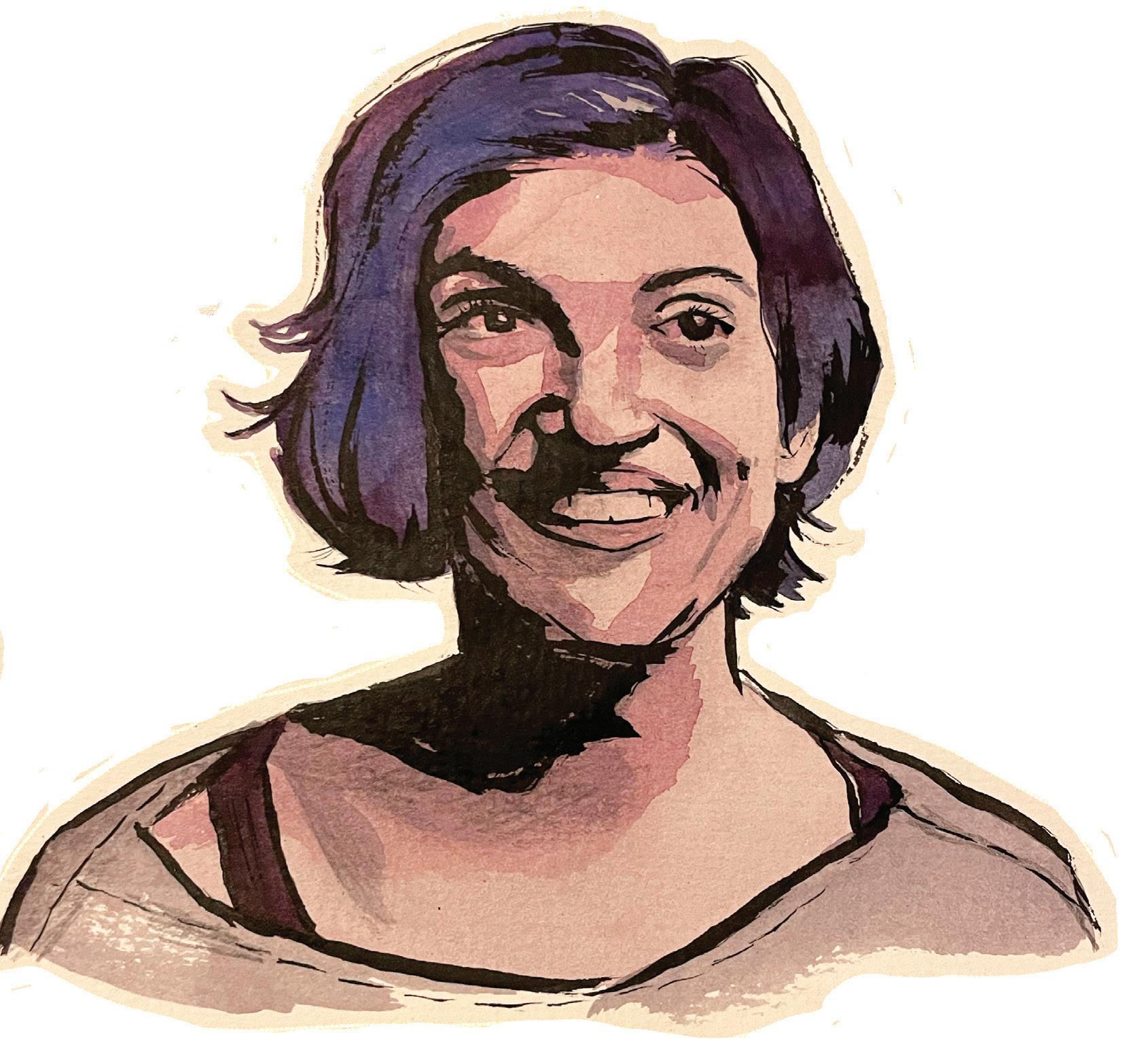
CB: I listened to your interview with Merve Emre at the London Review Bookshop, and you were talking about how you wanted to resist the urge to read novels as manuals, even though Selin does that over and over again. The Idiot was given to us as a manual, I think, about what to do— or, more likely, what not to do—in college. I was wondering how you felt about that.
EB So much of those books was about Selin feeling kind of put upon by the things that she’s expected to learn, or feeling skeptical of the things that she’s expected to learn, or [questioning] the things that count as part of the edifice of knowledge. When I heard that Brown was assigning it for freshmen, I was flattered and excited, but at the same time I felt this real unease that people would feel about my book the way that I had felt about all of these books that had been
foisted upon me … No one sets out to become a writer because they have this feeling of great social integration. If you felt that integrated, you would just be at picnics all the time. Everyone starts writing from a place on the outside, but then books become so incorporated into culture and become such a justifying part of culture that it’s hard to remember that aspect of them. And there’s something kind of dispiriting about realizing that you’re going to become part of the thing that people in the future are going to want to rebel from. But that’s just how it works.
I was thinking a lot about the idea of advice. When I look back, I did not take the advice that I now recognize as good advice. And I was thinking about why that is, and there was definitely an idea going around that is still very present now, which is that people actually can’t give you advice: you have to learn from your own mistakes. I think that idea is very much built into the novel. There’s a novel critic, René Girard, who has this essay called “The Unity of Novelistic Conclusions,” where he talks about every novel being a kind of conversion narrative where at the end the person realizes that the thing that they were doing the whole time was stupid. His journey of the novel is the journey of realizing that the thing you were interested in was an illusion. It starts with Don Quixote being like, “Oh, actually these books I was imitating about knights, I was on a misguided project.” … The novels are enacting the idea that you have to learn it for yourself.
I’ve been thinking a lot about early child hood and the concept of hazing. When we give young people advice, do we want to spare them the bad experiences we had, [and if so,] do we think we can spare them the bad experiences we had? Can we afford to think that they can be spared those experiences? Because such a big part of how we learn to live with our bad expe riences is by thinking, That was good for me, and I grew from it, and I’m better off now that I had that
CB: In Either/Or, Selin has made the choice to live an aesthetic life. There’s a line where she says she’s “trying to do the subtle monstrous thing where you figured out what you were doing and why.” But obviously, there’s a lot of pain involved in that choice. She doesn’t arrive at the end with some great answer. Do you think the choice to live aesthetically can effectively ever be made?
An interview with Elif Batuman about her novels
and how to live
life.
EB I think what Selin wants to live is not an aesthetic life the way Kierkegaard defines it … I think a much better manual if I had had access to it then—it existed, I just didn’t know about it—was The Ethics of Ambiguity by Simone de Beauvoir, where she basically shows that you can’t live an aesthetic life without it also being an ethical life because if you’re trying to live an aesthetic life and you’re trying to be free, but you’re actually hurting all of these people and hurting yourself, it’s not actually free … For Simone de Beauvoir, to live an aesthetic life is to always want to free yourself and others at the same time, and it’s that constant trying to free both that makes it a project.
Selin is interested and repulsed by Kant and the idea that you can make some kind of rule and just follow that rule for your whole entire life. And for Simone de Beauvoir, it’s kind of a bankrupt project. It makes the idea of the aesthetic versus the ethical life, or the idea of the categorical imperative, all look like the coping mechanisms of traumatized boys who then grew up into philosophers… But I find Simone de Beauvoir much more sane and sanity-producing. She’s basically like, You go into each situation, and you have to think: How do I free myself and others at the same time? Of course, you can’t do both of them simultaneously all the time, so sometimes you have to choose, and you have to know that you [are sometimes] going to make the wrong choice, but you can’t let that knowledge that you’re going to make the wrong choice prevent you from acting at all. You have to always act with the knowledge that you might be doing it wrong. That just seems much more true to me about the experience of living.
CB: What’s so essential to me about The Idiot and, looking back, what’s so true about the first year of college, is humiliation. There are just a lot of humiliating things that have to be done. Some part of that feels like a rite of passage, but with Selin, I don’t know that you have to hurt as much as she does to have an interesting life. Is there a way out of that conundrum?
EB I think a lot of what Selin does to herself is an internalization of the way that schools tend to deprive students of dignity in the same ways families tend to deprive children of dignity. I think all these things are super structural. I am
strongly, strongly opposed to the idea that you have to suffer to be a great artist, or that you have to suffer in some particular way. I’m kind of a utopian in that I think things could be arranged in a much more just and dignity-preserving way than they are … We’re gonna suffer anyway from death and from getting old. Art is about life and the experience of being alive.
Sometimes I do wonder, if we had a much more just and whole society and more social integration, would we even need art anymore? And that thought used to kind of disturb me when I was younger, I didn’t want to think about a world where we didn’t have art. But now I actu ally find it kind of exciting. But I don’t think you have to go out of your way to suffer to become an artist.
CB: There’s a scene in The Idiot where Selin knows this girl who wants to be a writer and to do so, this girl interns at New York Magazine. Then there’s Selin who wants to be a writer, but she’s going to a village in Hungary. These seem like the two paths for the contemporary aspiring writer: professional experience or life experience. Selin is the person who, as you say in The Idiot, thinks you have to keep the “creepy stuffed weasel” in your room if you ever want to be a writer. And then there’s the person interning at the maga zine. It doesn’t seem like in the book you come down on the right way to go about it.
EB There are two ways of answering that: One is what advice would I give to someone who wants to be a writer who’s Selin’s age, the other is how do I now think about it for myself? I spent a lot of my youth chasing prestige. It was really important for me to get into Harvard, that was something that I internalized from my mom … I did not think of that as fetishizing power, but now I see that it totally is, but those power and prestige relationships distort our ability to be human and normal and think, and those are the things that help us to be a writer. So to that extent, I’d say you’re better off with the weasel.
That said, I think Selin’s ended up in that weasel situation by following whatever comes to
her. She’s gotten there in a reactive sort of way, and there’s a sense that she doesn’t want to be there. And I think that she’s making it harder than it has to be, too.
But it’s so hard to be 18 or 19. It’s not like you have unlimited choices about what you can do. Try to do things that are going to make you happy and excited on a day-to-day basis. Like the thing that you think about when you get up in the morning, what am I really excited to do, who am I excited to be around? I would say think more about building community instead of collecting experiences that you can go off by yourself and write about, unless that’s what you wanna do, and then that’s what you should be doing.
CB: Especially in Either/Or, you talk about the shame of writing about yourself. Selin wants to create rich fictional characters, but she can’t. At Brown, one of the most competitive classes to get into now is Creative Nonfiction. Writing autobiographically, or even autofictively, is in the academy in a way that it wasn’t in Selin’s time. What are the consequences of that? How has the shame around writing autobiographically changed?
EB I do think that a lot of the shame has dissipated. Part of the shame is in the idea of the subject matter … There can be an idea that the risk in writing is that it will be self-indulgent, or, I don’t want my writing to be therapy, I don’t want my writing to be navel-gazing. I don’t think that shame is helpful at all. It’s true that critical thinking is always good, but I think we can actually think more critically when we’re not feeling shame. If you don’t have [shame], you can just be like, huh, my mind is going to this now, I wonder why it’s doing that. Because actually none of this stuff is personal. This is something that really comes up through meditation. They don’t talk much about my brain, the brain just works in a certain way and tends to go in these particular circuits, there are things that are helpful and unhelpful. But there’s nothing to feel ashamed of. I think the more we can get away from that, the better it is
for writing, and the better it is for understanding.
CB: You’ve talked in interviews about your experience with therapy and what that’s done for you. In The Idiot and Either/Or, Selin has a couple failed encounters with therapists and psychia trists, but then Svetlana, her best friend, is this figure who’s extremely psychoanalytical and this product of psychoanalysis. Selin is very drawn to her. I was wondering if you could touch on your experiences with that and what Svetlana is doing in the book.
EB Part of the motivation for writing Either/ Or was realizing the extent of how much happier I was at age 40 than I was at age 20, and how much of that was because of concepts or insti tutions or modes of being that I was aware of at 20, but I didn’t think were for me. The main ones were lesbianism and psychotherapy, and to some extent the idea of political consciousness and queer consciousness and psychoanalytic theory. I read Shulamith Firestone and her reading of Freud, and how Freud makes all the right obser vations of feminism, but instead of drawing the right conclusion—which is that we have to end these structures that cause pain—he’s trying to pathologize the pain and cure it. I just thought that was completely brilliant, and it would have been a game-changer if I had known about it younger. Or, I don’t know, maybe it wouldn’t have been.
[When writing] Either/Or, I read “Compulsory Heterosexuality” by Adrienne Rich and the way young women are ideologically programmed into certain paths, and the one that I went into I thought of as something that I chose freely. I became this very critical literary person. But that was following a certain ideolog ical pattern. And part of that was—Shulamith Firestone talks about this—we’re encouraged to believe that our problems are of our own making: no one can really help you with your own problems, and stop being such a baby. All the social liberation programs already happened, and if you’re not happy now, that proves that it didn’t work and that there’s more work you have to do, and stop whining and looking to someone else to solve your problems. And I really believed in that. That was a mode that people used to discourage therapy: No one else can solve your problem, you have to solve your problems yourself And Firestone is pointing out that the origin
of that—or not the origin necessarily, but the effect—is to depoliticize people, to keep people in their individualistic bubbles, to prevent the flow of information, to prevent people from coalition-forming. It ends up preserving the status quo, it keeps the people who are in power in power, because everyone else is in their own box like, “I have to solve my own thing.” People aren’t getting help, and people aren’t talking to each other.
It’s kind of the same thing with what I thought of love. I thought that love was this particular, hetero, one-on-one, really private rela tionship that you can’t really explain to anyone else, and you’re just sort of in it. What I wanted to do in Either/Or was ask, to what extent did I know about the alternatives? To what extent was I aware of Freud, was I aware of the practice of therapy, was I aware of lesbianism, was I aware of feminist theory? I specifically showed Selin encountering all of these things. I wanted to show all of these missed encounters and to show what it was about them that made me or made Selin think, That’s not for me, and that made it seem like it wasn’t liberating for her, and, to the contrary, made it seem like liberation was some where else. Or that made her think, I don’t deserve this, as was the case with therapy …
That part is really autobiographical too, in that I did benefit from antidepressants when I was in college, and my parents really are both doctors, and I grew up with a very M.D.-centric view of treatment in general. I only tried psychi atry, which was focused a lot on medications. They were doing talk therapy, but it was not at all questioning the political causes. No one was questioning the structure of the family or the idea that when you’re in a healthy relation ship—meaning some guy is fucking you once a week—then that’s the proof that you’re a mature person. None of that was being questioned. The therapists who [actually] helped me were not M.D.s. It was two people, both of whom had Ph.D.s and both of whom had a critical theory angle. They were more about how to negotiate within this world with its structures, instead of adapting yourself to those structures.
CB: Your answer to this question could be that no one should ever ask this question to you. But The Idiot came out before our first year, Either/ Or came out before our senior year. What would your advice be to a graduating senior?
EB It’s similar to the New York Magazine vs. the weasel. We all need to survive in a capitalist world, and to that extent we do have to please these institutions. I would say, don’t identify too much with power. Just because someone is the boss of the university or the magazine doesn’t mean that they’re right and you’re wrong. Keep an eye on yourself and what you think and what you want. Just keep that line with yourself open. I think that I was very skeptical when I was younger. I don’t even know to what extent this is true and to what extent this is Selin, because I couldn’t remember all of it, so I kind of made it up. Selin is very skeptical. Whenever someone older or important or powerful says something, she’s like, Why’s he saying that? What’s the point of that? Is that stupid? Is that not stupid? How could this person be at Harvard and be saying stupid stuff? In that way there’s that constant skeptical stream.
But there’s another way that she’s really willing to turn off her judgment of things. She’s like, Huh, clearly Kierkegaard’s Diary of a Seducer is about carnage, it’s about someone who’s a sociopath going around systematically torturing young women to death. And instead of thinking, Well, I guess this is not a useful book for me, she’s like, I have to find a way of adapting myself to this or adapting this to the world. There’s some extent to which she’s identified with certain forms of power. Kierkegaard is a brand name for something that’s really smart and interesting and valuable. She’s aware of her own skeptical responses, but to her they don’t seem like a reason to act. I would just say don’t turn that off. You know better than the people who are telling you what to do.
CECILIA BARRON B’24 is weaseling her way into New York Magazine
content warning: abortion, pregnancy, racism, and discrimination.
“I urge each one of us here to reach down into that deep place of knowledge inside herself and touch that terror and loathing of any different that lives there. See whose face it wears. Then the personal as the political can begin to illumi nate all our choices.”
In the spring of 1977, a group of Black feminists and lesbians gathered in Boston, Massachusetts to publish the Combahee River Collective Statement. This statement defined contemporary Black feminism by centering “the manifold and simultaneous oppressions that all women of color face.” American writer, professor, and civil rights activist Audre Lorde was among those in attendance.

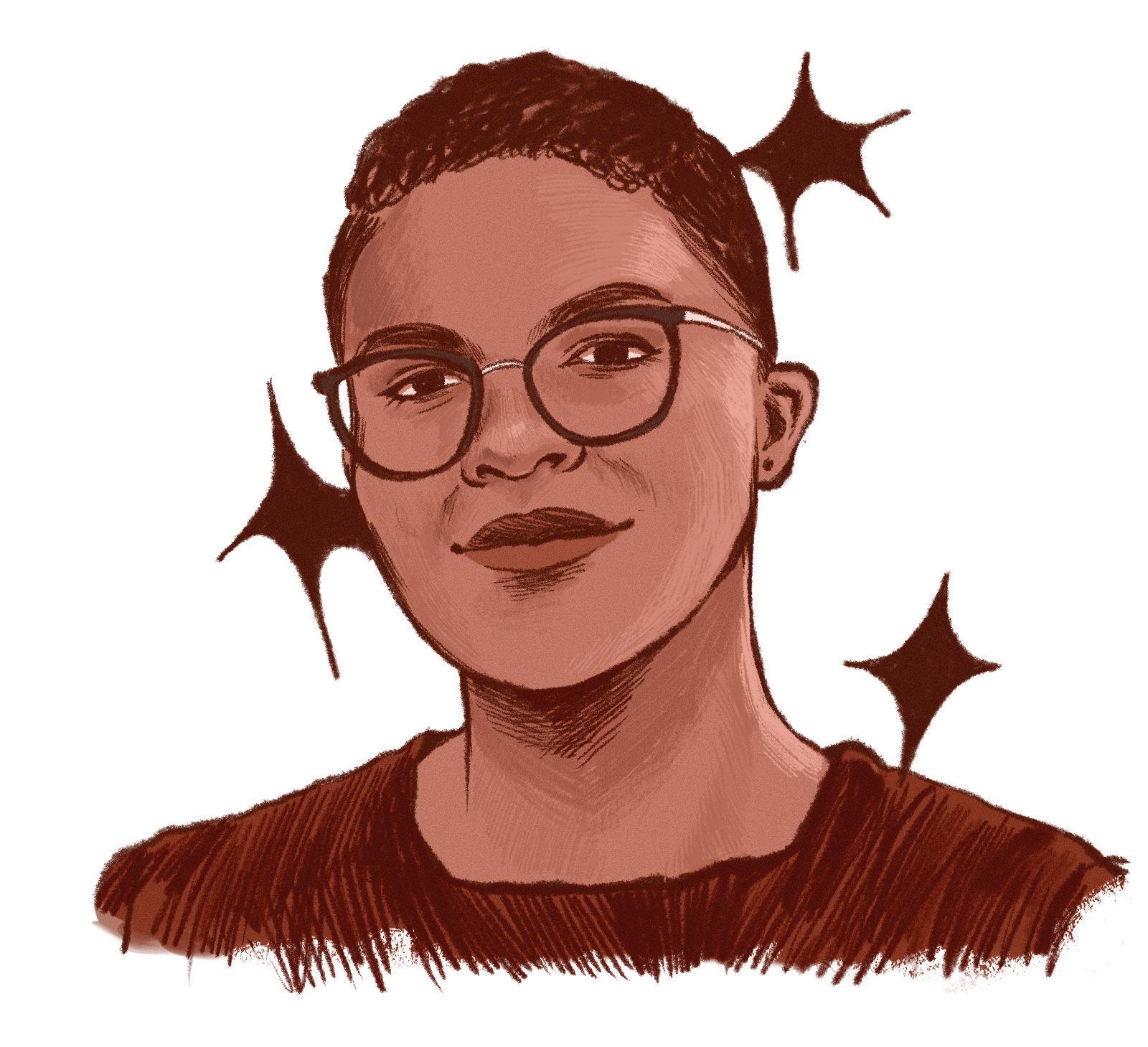
This group’s name came from the Combahee Ferry Raid, a Union Army attack led by Harriet Tubman in 1863. A co-founder of the organi zation, Barbara Smith, recognized the need for distinct political action in response to the expe riences of Black women. Feminist movements at the time were largely governed by white women who lacked empathy and understanding of the Black experience, while the civil rights move ment was overwhelmingly masculine.
The synthesis of these identities was the framework upon which reproductive justice was built: a movement rooted in resisting the marginalization of bodies along intersecting axes of oppression. Reproductive justice cannot and should not be reduced solely to family planning and abortion rights. Rather, this human right to bodily autonomy should encompass one’s entire standard of living, including access to health resources, voting rights, racial justice, income equality, and protection from police violence. Achieving this level of universal access requires us to confront how these power dynamics inten sify at the crossroads of identity politics.
The Supreme Court’s recent decision in Dobbs v. Jackson Women’s Health Organization held that the U.S. Constitution does not confer a right to abortion. This rejection of nearly 50 years of protection under Roe v. Wade will likely lead to the outright ban of abortion in nearly half of U.S. states. But the right to an abortion was actually lost much earlier, with the passage of the first Hyde Amendment in 1977, which prohibited the expenditure of federal funds on abortions. In the U.S., the legal right to an abortion does not constitute the right to access an abortion. This highly discriminatory policy prevents Medicaid and other public insurance programs from funding abortions, which disproportionately harms Black and brown communities.
In 2019, the state of Rhode Island passed the Reproductive Privacy Act, codifying the right to an abortion in state legisture—for those who can afford it. In other words, individuals using state-funded insurance or Medicaid will still not have access. These policies represent a cruel perpetuation of systemic racism in the healthcare industry in the U.S., which specifically harms low-income people who are disproportionately people of color. This illuminates the core of the issue: reproductive justice is, and always has been, an intersectional issue.
In July, a collective of activist groups in Rhode Island published an open letter to Governor Dan McKee in support of the Equality in Abortion Coverage Act (EACA). This act would eliminate the policy that denies health coverage for abortion under Medicaid and associated plans, including those used by state employees. The number of employees on the state payroll as of 2018 was around 14,000, the highest number reported for Rhode Island since 2008; in addition, the number of Rhode Islanders receiving Medicaid expanded by over 40,000

people from the beginning of the COVID-19 pandemic to April 2021. Both of these statistics fail to include the many immigrants and undoc umented people who already encounter impedi ments to health services; for these communities, the threat of contact with the criminal legal system invokes fears of detention, deportation, and family separation. The letter to Governor McKee closes as follows: “We must act urgently as if our lives depend on it, because they do.”
As stated by the Women’s Health and Education Fund (WHEF), the average cost of an abortion in Rhode Island is around $600; for many people, having this procedure would require giving up other necessities like groceries and rent money. The SCOTUS decision will not prevent abortions from happening, but it will change where they are able to happen and for whom. This inequity is exacerbated as abortion rights fall under state jurisdiction; not only are certain states deprived of necessary access, but states where such services are still offered are strained with the influx of out-of-state patients seeking care, overwhelming available staff and resources. Those unable to afford travel to legalized areas will inevitably seek more drastic measures; unhygienic, unlicensed, and self-inflicted abortions are life-threatening procedures. This is part of a larger relationship between financial stability and the right to bodily autonomy in the U.S., as the insufficient protections provided by preventative care, paid leave policies, and childcare services continue to restrict low-income people and people of color within an irreparable underclass.
It’s no secret that the overturning of Roe v. Wade has been met with resistance on a national level as pressures are put on President Biden to declare a public health emergency. Under such a declaration, state governors can use their legislative power to issue executive orders that would protect access to abortion. In Rhode Island, the legislation needed to remove barriers against state-funded abortion coverage failed in the previous two General Assembly sessions, meaning the ballot for affordable reproductive

care will continue to be delayed until the assembly reconvenes in January.
The stewards of the effort to pass the EACA were two local community-based nonprofit organizations, the Womxn Project and SISTA Fire. Both of these groups are dedicated to the collective power and solidarity between people affected by reproductive justice issues, specifically Black women and queer people. This issue has been avidly endorsed by commu nity organizers and members of the assembly, notably including Rhode Island senator Tiara Mack (D-Providence): the first openly queer Black person to serve in the State Senate. In an interview with LGBTQ Nation, she reflected on the GOP and anti-human rights campaigns, saying they were “centered and targeted towards people’s access to bodily autonomy.” Despite the threats to reproductive justice and the long inac tion of prior administrations, Mack expresses a great deal of faith in other young people and community building amongst activists in Rhode Island. This work is instrumental in reframing politics as something that we all are affected by and likewise can play a role in. “When you are unapologetically yourself,” Mack says, “and you stand firmly in the beliefs that are grounded in people and rights and equity, you can’t lose.”

The overturning of Roe v. Wade has significant implications for queer people, most obviously through the fact that the Dobbs decisions targets the same foundations used to defend trans rights and same-sex intimacy through the Due Process Clause. Under the 14th Amendment, the government and courts are required to uphold the human right to equal protection under law— which should include reproductive autonomy. Beyond the scope of reproductive care, the Dobbs decision immediately endangered any right not explicitly outlined in the constitution. It seems that the absence of intersectionality from the discourse of reproductive justice has exposed the cracks in judicial interpretations of equality.
It’s difficult to conceptualize the significance of these decisions in historically blue states like Rhode Island, which prides itself on being highly liberal and at the forefront of transgender and
LGBTQ+ visibility. But Rhode Island, as the most Catholic state in the nation, also functions under a religious prerogative. Religious groups have frequently collided with feminist and queer rights activists in state legislation. Even with the majority of voters supporting the rights of trans and non-binary folks and the liberal agenda as a whole, the substantial presence of pro-life rhetoric continues to pose a threat to bodily autonomy.
This year, Rhode Island legislators intro duced two new bills representing the most antitrans legislation in the state’s recent history. The first of these bills, S2501, bans the participation of trans girls in school sports. H7539, the second bill, would prohibit inclusive sex education for LGBTQ+ youth, restrict curriculum relating to racism and oppression, and prevent trans and non-binary students from being addressed by their preferred names and pronouns. These bills directly attack the gender identities of children, denying them bodily autonomy. According to a 2017 survey by the Human Rights Campaign Foundation, 63% of Black and African American transgender and gender-expansive youth try to avoid using the restroom at school. This kind of alienation perpetuates structures of surveillance and fosters hostility in what should be an inclu sive and safe educational environment.
The intersection between the attack on abortion and LGBTQ+ rights is also evident in the disturbing rise of digital surveillance by law enforcement agencies. License plate data, registered pregnancies, period tracking apps, and internet history have all been used by prosecutors to build cases against people who have abortions in states where they have been criminalized. Criminal attorneys can issue search warrants to request private user information through third-party platforms. For LGBTQ+ people, the surveillance of dating apps puts their privacy at risk by exposing sensitive information such as sexual orientation, location, and HIV status, offering an example of how the attack on abortion rights mirrors a broader struggle for bodily autonomy among the queer community.
To quote Black feminist legal theorist and civil rights scholar Kimberlé Crenshaw, “This process of seeing what was previously viewed as isolated and individual as societal and system atic has … characterized the identity politics of African Americans, other people of color, and gays and lesbians ... ” Or, for marginalized identi ties, above all, the personal is political.
The post-Roe world bestows upon us a common adversary: hopelessness. Despite the apparent bleakness of our current legislature, the commu nity connections forged through resistance present a springboard for progressive action. Reproductive justice advocates around the country recognize that choice is meaningless without access. Until mainstream feminism centers intersectional thinking and solidarity, the repressive policies of the past will persist under an artificial lens of inclusivity. It is only when the most marginalized individuals possess the full human right to self-determined living that our society becomes truly free from gendered, sexual, and racial inhibitions.
Intersectionality enables previously silenced communities to raise their voices as one, uplifting other marginalized people and reframing the discourse surrounding reproduc tive rights. It is the hope of many that recogni tion of these issues will help to end the stigma surrounding bodies with uteruses. Tiara Mack has widely advocated for the value of inclusive education; by encouraging vulnerability and authenticity in conversations about reproductive justice, these issues can be destigmatized for future generations. Comprehensive, queer-in clusive, and pleasure-based sexual education for young people is critically important to ending the demonization of sex and negative attitudes towards modes of contraception. Teaching inclusivity and acceptance equips young people with skills and knowledge for forming healthy relationships, making informed sexual decisions, and growing love and appreciation for them selves and their bodies.
Revolution never happened in isolation. Rather, this change will happen through commu nity action and the uplifting of intersectional identities. As Mack puts it: “We are not singleissue people with single-issue lives.”
KEELIN GAUGHAN B’25 hopes that you’ve registered to vote.
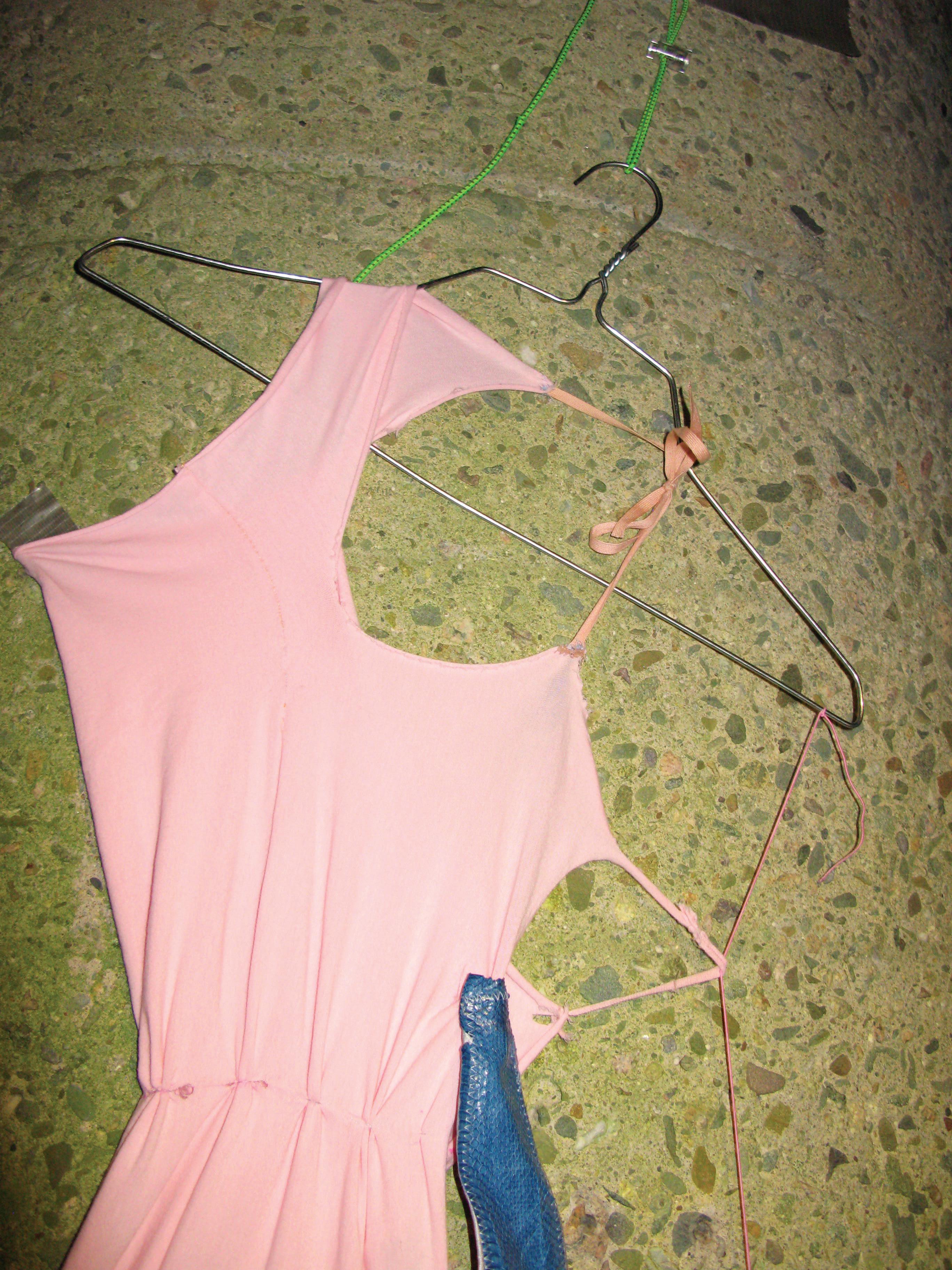
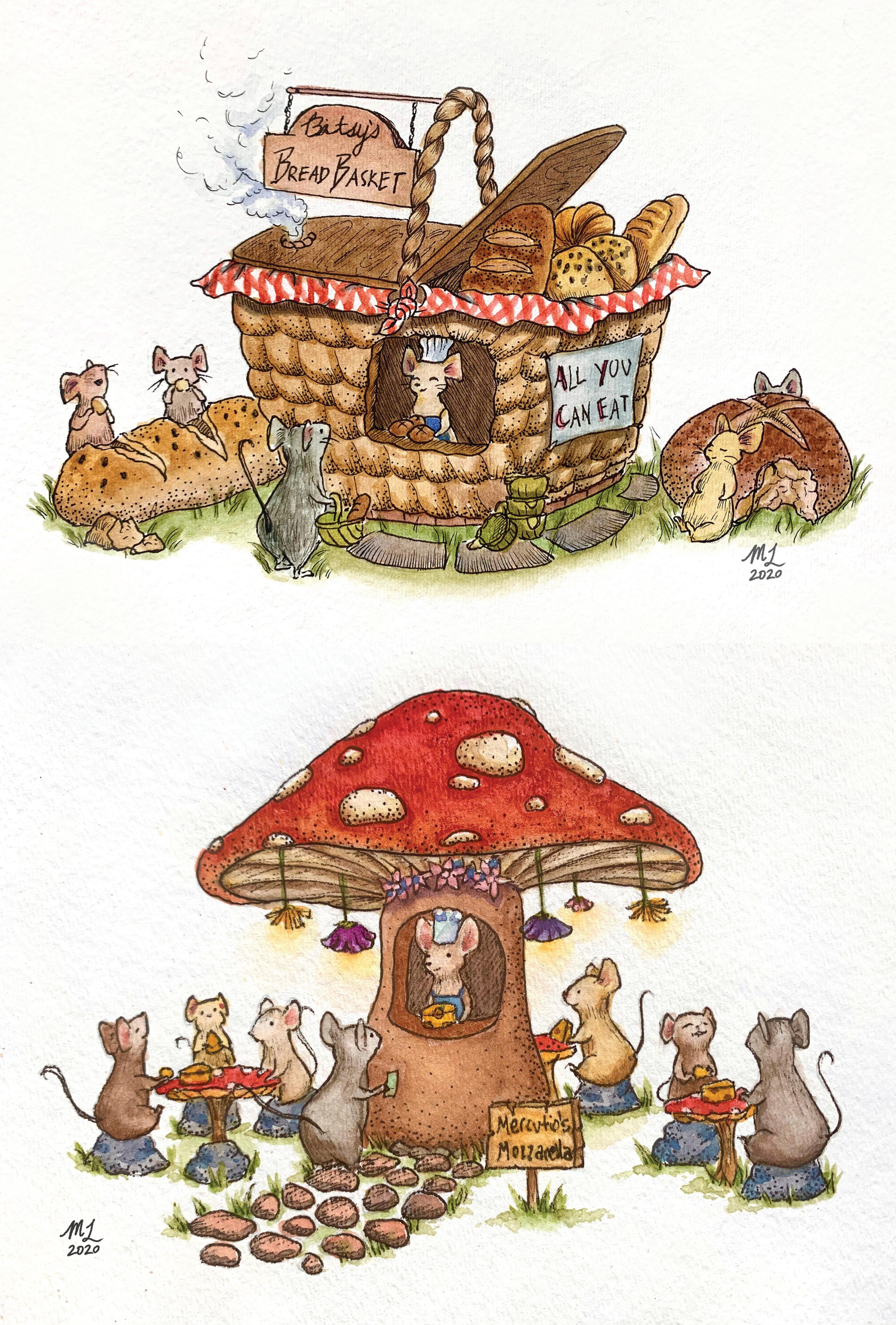
When I visited Nepal as a kid, I didn’t think my family there was particularly privileged. Sure, we had an actual house rather than the ramshackle aluminum huts you encounter in the alleyways of the city, but the showers were always cold and water had to be delivered by a bottled water company rather than drunk straight out of the tap, so I assumed we were somewhere in the middle.
As I grew older, I realized how incredibly privileged my family is. In addition to being well-off compared to the general population, we are Brahmins, which is the highest caste according to the Hindu caste system. Even though the caste system has been legally abol ished in Nepal for decades now, caste-based discrimination and violence are still grim realities. Dalits, a term reclaimed by communities relegated to the lowest strata within the caste system, face higher poverty rates as compared to other caste groups. They currently make up only around eight-percent of the Nepali parliament.
Some members of my family struggle to reckon with their privilege. They don’t understand why Nepal needs affirmative action for Dalit people, saying things along the lines of: “So you’re telling me a hardworking Brahmin boy will now be rejected from jobs just because he’s Brahmin?” What I hear in the living rooms of some of my relatives in Nepal feels eerily similar to the discourse surrounding college admissions in the United States.
This summer, I returned to Nepal. Kathmandu’s mayoral elections had just happened, and I heard that an ‘underdog’ rapper-turned-politician named Balen had won. What I learned is that the election of Balen was not just an isolated event, but a reflection of the larger sociopolitical patterns of Nepal as well as a commentary on my family’s privilege.
+++
Being a biracial kid growing up in the United States is almost oxymoronic. The second the plane wheels hit the tarmac of the Kathmandu airport and my family greets me with Namastes and hugs, I feel like I’m home. Yet, at the same time, I struggle to comprehend the spoken language and am illiterate in Nepali. I know so little about Nepali politics and history, which in itself is a confession of the privilege of my family. Not knowing about Nepali politics means you don’t know anybody personally affected by the violence of the recent Maoist uprisings, means your family doesn’t belong to a systemically persecuted ethnic group, means that your family
hasn’t been affected by caste discrimination.
This summer, I decided I was going to change things. Here’s what I learned: the area that is now Nepal was once a plethora of small kingdoms governed by local kings until Prithvi Narayan Shah, from the Gorkhali kingdom, decided to conquer the neighboring kingdoms in the mid-1700s. Then, for a while, Nepal was even bigger than it is today, ruled over by the Gorkhas, until the British-Nepali war, which reduced Nepal’s borders to what they are today. (Most Nepalis today will begrudgingly call the war a ‘stalemate,’ a nationalistic rhetoric created to portray ourselves as better than other South Asian countries, even though Nepal lost 176,000 acres of land.) Nepal was then ruled by a monarchy and didn’t officially become a democracy until 2008. There were attempts at a monarchy-controlled Congress in the years leading up to the last king of Nepal walking away from the throne in 2008 due to popular pressure. The current Nepali constitution wasn’t approved until 2015, largely due to disagreements between the political parties.
Obviously, this summary of Nepal’s history lacks any sort of nuance, but seeing as the only things the average person knows about Nepal
election. With that proclamation, my uncle went from someone who I viewed as the very epitome of Nepali stoicism (“ke garne” – what can you do?) to the living embodiment of lunacy. How could my uncle, an intelligent man, vote for a rapper with no political experience?
At least my uncle voted. My two cousins aren’t registered to vote, displaying an indiffer ence to politics I see as yet another example of our family’s privilege. Yes, Nepali government offices are dysfunctional, but that’s no excuse for complacency. Especially seeing as virtual voter registration is now an option in Nepal, their flimsy excuses for not voting become even weaker.
But, even my family can’t be confined to a single story of complacency—for example, one of my uncles was involved in the democracy move ment of the mid-to-late-1900s. As I read more about Nepali history that summer and learned about the blood, sweat, and tears that people like my uncle put into Nepal’s fight for democracy, the apathy of certain family members infuriated me.

Similarly, Balen, the now-mayor of Kathmandu, proclaimed on social media in 2016, “I did not vote today. I was not a candi date. I graduated in Civil Engineering, I am halfway through my Masters in Structural Engineering. I want to build a country. I will vote next time, and vote for myself. I develop my country. I don’t depend on anyone else.” This quote reminds me of the younger members of my family, who justify their political apathy by citing the bad track records of politicians and a lack of faith in any of the presented candidates, but refuse to acknowledge that political apathy is still
course in Nepali history.
There is a tendency to assume the politics of all countries of the Global South are not progres sive, but Nepal, like all countries, is complex. It is progressive on abortion rights (women can seek abortion for any reason for up to 12 weeks) and the government legally recognizes nonbinary people. Obviously, there still exist social strug gles and difficulties in implementing these laws, but the legislation is progressive nonetheless.
While perusing the Kathmandu Post in my desperate attempt to get up to date on Nepali politics, I discovered that there had recently been a mayoral election, and a rapper named Balen had won.
Then, as I walked through the humid streets of Kathmandu with my family on the way to a relative’s house, my uncle announced that he voted for Balen in the recent Kathmandu mayoral
But who is Balen, anyway? As I found out, Balen, or as his young supporters call him, ‘Balen Dai’ (‘dai’ meaning ‘older brother’) is a 32-year-old civil engineer and rapper. He is known for his relief efforts following the 2015 Nepal earthquake and his involvement in the “We for Constitution” move ment. This group aimed to put pressure on the government to resolve the pre-2015 governmental gridlock and pass a constitution, according to his campaign website. Ultimately though, it was his charisma and fame as a rapper that cemented Balen’s public image, with the song “Balidan” (meaning “sacrifice”) skyrocketing to over 6 million views prior to the election.
What I was initially told about Balen mirrored much of the misleading political infor mation I’ve accepted as truth from my family throughout the years. I accepted that Nepal was ‘united’ by the Gorkha warriors’ conquest, which erased the inherent violence that comes with conquest and also the marginalization of the Newar people of Kathmandu Valley. Similarly, my family members would tell me that Nepal “never got around to” writing a constitution before 2015, as if politicians simply forgot to draft the important document. (Yes, I believed

this, really.) I accepted these political falsehoods as truth because I assumed my family who actu ally lived there knew better than I did. Had I been younger, maybe I would have accepted the way my family spoke about Balen—a young go-getter not involved with the corrupt, established parties who would bring much-needed change to Kathmandu—as objective truth. In fact, the people who responded most positively to his campaign were those who agreed with this narra tive, due to their frustration with elite politics.
But what are the changes that Kathmandu so desperately needs? According to my family, the biggest problems are motorbikes crowding the streets and trash everywhere—another reflec tion of the privilege we hold in Kathmandu, if those are what we’ve identified as the largest issues facing our city. According to “The Social Construction of Balen Shah,” an article written by journalist Pragyan Thapa Ghimire for inde pendent Nepali newspaper The Record, growing economic inequality, inflation, unemployment, air pollution, and lack of infrastructure are considered to be the biggest issues facing the city. At the Kathmandu mayoral debates, issues discussed included how to deal with monsoon flooding, implement better water supply, and organize our public transportation systems.
Additionally, the voting demographics of Kathmandu are complicated, as there’s been a recent surge in voter registration and many people who live in Kathmandu don’t vote there. With the 1996–2006 Maoist war’s violence in the more remote parts of Nepal, more educa tional and work opportunities arising in the big city, and small villages being destroyed by the 2015 earthquake, the number of migrants to Kathmandu has been steadily increasing. As of March 31 of this year, half the people registered to vote in the May 13 local elections (which included the mayoral race) were from outside of Kathmandu.
Despite Kathmandu’s huge population, the city’s voter turnout is low in comparison to the rest of the country, ranking third nationwide. Increasing lack of faith in the government continues to be a persistent issue throughout Nepal, as voter turnout for elections across the country fell by 10% this year. Corruption scandals combined with a lack of fulfillment of campaign promises has led to lower political participation overall, but particularly amongst Nepali youth. However, this is not to say that political activism among young Nepalis is dead—for instance, young people organized protests and sit-ins over the government’s lack of response to the COVID-19 crisis.
Balen’s status as an independent candidate set him apart from all that in the eyes of the public. The current two most influential political parties in Nepal are the Nepali Congress and the Communist Party of Nepal (Unified Marxist–Leninist), but there are currently seven political parties recognized in the national parliament. Running as part of a party gives you access to funding and lobbying, but oftentimes, candidates find themselves indebted to the interests of the party that helped them win.
By running as an independent, Balen empha sized that he wouldn’t be tied to a party and could instead speak for the constituents, playing on a long history of disillusionment with the
political parties of Nepal. Balen also promised transparency, but with his dedication to trans parency comes his stance in favor of a dramatic increase in state surveillance. He stated in his election manifesto that there will be “manda tory CCTV connection in all public transport for security.”
Another important part of his campaign was his history in civil engineering, seeing as Kathmandu is riddled with infrastructure prob lems. Examples include his claim that 70% of the Kathmandu city budget is written using infra structure and civil engineering terms and that being a civil engineer has given him a knowledge of “everything.” However, there are important social nuances behind the building of infrastruc ture, especially in a city as diverse as Kathmandu. Balen’s technical expertise isn’t as all-encom passing as he makes it out to be.
Balen also took advantage of existing hierarchies by mobilizing the high social status that careers like engineering and medicine carry in Nepal. (Only last summer did I tell my relatives that I’ll probably be an English major.) Balen frequently cited the money he’s made from his engineering projects as proof of his integrity. Balen claimed that due to the money he’s already made, there’s no financial gain he could get from being mayor.
Balen also made a special effort to appeal to Newa voters, an ethnic group of the Kathmandu Valley, and promised to incorporate Newa language, history, and culture into the curricula of Kathmandu schools. However, when asked in an interview about his own ethnic identity, he claimed that any sort of participation in Newa culture makes you Newar and that before the Shah kings conquered the Kathamandu Valley, everyone in that region was Newa. This completely contradicts the situation in Nepal today, as Newa are a defined ethnic and linguistic group. The rhetoric of Balen’s campaign was almost post-ethnic, as he frequently refused to comment on his ethnicity, remarking that such questions were not important and “casteist.” It is notable that he also doesn’t use his full name in his campaign promotion, just going by ‘Balen’ rather than ‘Balen Shah’ because your last name identifies you with your caste in Nepal.
Balen’s fame as a rapper cannot be under estimated—his well-known status of celebrity among the youths of Nepal saved him time that other grassroots politicians would need for advertising themselves to the public. Through social media and a targeted PR campaign, he constructed a new persona: the no-nonsense man behind the dark sunglasses.

Balen won the Kathmandu mayoral election on May 13, 2022 with 38.6% of the vote. After the victory was announced, the streets were filled with supporters celebrating the triumph of their ‘underdog’ candidate. (And can Balen— someone coming into this election with money and name-recognition—really be as much of an ‘underdog’ as his supporters make him out to be?)
Balen’s victory must be seen as a trend—independent candidates triumphed over party candidates in the recent May 13 elections, not just in the Kathmandu mayoral race. Balen’s election fundamentally disproved the idea that parties are invincible—his
two major opponents were both from prominent, established parties with political careers behind them. Some see this as the start of a vibrant new progressive era, in which independent candidates could overtake party politicians. More broadly, Balen’s election is a reflection of the larger prob lems facing Nepal, from distrust in the political parties due to scandal and corruption to a desire for a ‘post-ethnic’ society that doesn’t ‘see’ caste or ethnicity.
Balen was sworn in a little less than five months ago on May 30, 2022. In the list he’s published of his accomplishments in his first 100 days in office, he emphasized the removal of unau thorized vendors from footpaths, livestreamed city council meetings to increase transparency, and demolished illegal structures. This move generated controversy, as owners of the build ings said they didn’t receive proper notice of the demolitions, and the due processes for building demolition weren’t properly followed. Many also criticized Balen as tacky for taking a camera crew to film these demolitions.
The case of Balen is an example of the tendency to idealize people and simplify events in order to serve certain narratives. It’s much easier to proudly buy into the nationalist narra tive that Prithvi Narayan Shah unified the nation, rather than admit that there was a lot of violence involved in the so-called “unification” of Nepal. Similarly, it’s easier to characterize Balen as this anti-establishment figure who will revolutionize Kathmandu rather than a carefully crafted public persona who played on appealing rhetorics in order to win the mayoral election. He’s a poli tician, a truth many seem reluctant to accept. We must be careful, as this tendency to over simplify leads to false, harmful narratives that end up perpetuating existing systems of power and nationalism that marginalize disadvantaged groups.
After the mayoral elections, some of my relatives proudly told me they voted for Balen, confessing it to me as if it were a bold, radical act. And the idea of an independent candidate beating someone from an established political party is pretty ground-breaking in Nepal, hence the feeling of clandestine excitement I would pick up on whenever an uncle or cousin told me they voted for Balen. However, there is nothing radical about privileged people voting for a candidate whose dream seems to be a colorblind, ‘post-ethnic’ society. What would be radical would be recognizing our privilege and figuring out how we can be allies to marginalized groups in Nepal.








This week, we asked our contributors to closely mirror the style and/or form of writers known for their distinctive voices. How does your content change when you’re asked to write within a very specific meter or conceit? What does the page demand of you when you sit down to write within a preconceived form? In the following pieces, our contributors have challenged themselves to emulate the works of Anne Carson, poet, essayist, Classics professor, and translator; Peter Markus, novelist and fiction writer; and Diana Khoi Nguyen, poet and multi media artist. In replicating the sounds, shapes, structures, and motion of these writers’ works, our contributors’ original words are elevated by the literary tradition they follow.

TETRAPTYCH In the style and form of Diana Khoi Nguyen’s “Triptych” and “Gyotaku” from Ghost Of
By Lily LustigIn the style and form of Diana Khoi Nguyen’s “The Birdhouse in the Jungle”
By Lily LustigLILY LUSTIG B’23 is working on apologizing less.
In the style of Peter Markus’ “The Hands That Hold The Hammer”
By Tierra SherlockWhen we were younger, us friends, we dipped our fingers in papier-mâché, and with our fingers, the fingers of us friends, we marked an act of creation. One of us friends took a new sheet of newspaper and ripped it down the middle. The front-facing sheet of the Sunday spread halved for the hands of us. Stop ripping paper, teacher said to our torn strips and sticky fingers. Put away the glue, your time is up. The sets of sticky fingers of us friends turned to splitting fingers, strips of the Sunday spread. Us friends picked the newspaper loose with our sticky splitting fin the edges of the funny pages. We unscrewed more glue caps and poured more protest into papier-mâché. The old glue hardened into skin around our fingers, those of us friends, but they leaked a little wet when we plunged them back into the paste. We dredged the Sunday strips in paste and with our glue-swollen fingers, we lined the inside of a bowl. Accumulating flesh, the shriveled fingers of us friends wriggled warm and a little wet and under the new skin. Listen, times up, teacher said. So us friends turned our fingers to ears. We built from torn Sundays and shriveled fibers. Laying gluey newspaper over our ears, us friends poured paste over our skulls. Clean up the craft table, teacher said to our freshly coated heads, the paste-filled hollows of us friends. We couldn’t hear through the hardening papier-mâché, but we could read teacher’s lips. Our sticky splitting fingers worked in spite of her words, laying the glue on thicker. The paste squished warm and a little wet inside our ear canals. The feathered edges of the Sunday spread tickled our insides, the insides of us friends. Wash your hands, teacher mouthed to our swollen fingers and hardened skin. We dredged the strips of skin in paste and with our flesh-soaked fingers, those of us friends, we lined the inside of teacher’s mouth with protest. One of us friends took the front-facing sheet of her Sunday best and ripped it down the middle. Halved for the hands of us. We dredged the Sunday strips in paste and with our flesh-soaked fingers, those by us friends, we turned our fingers to mouths. We lined the inside of teacher’s mouth with gluey strips, and we felt her smile, warm and a little wet under the new skin. The fingers of us friends, the sticky Sunday splitting fingers of us friends, layered the feathered pages thicker into her mouth, but we didn’t hear teacher laugh. Our fingers, the fingers of us friends, mouthed creation, and teacher’s papi er-mâché mouth couldn’t tell us to stop.
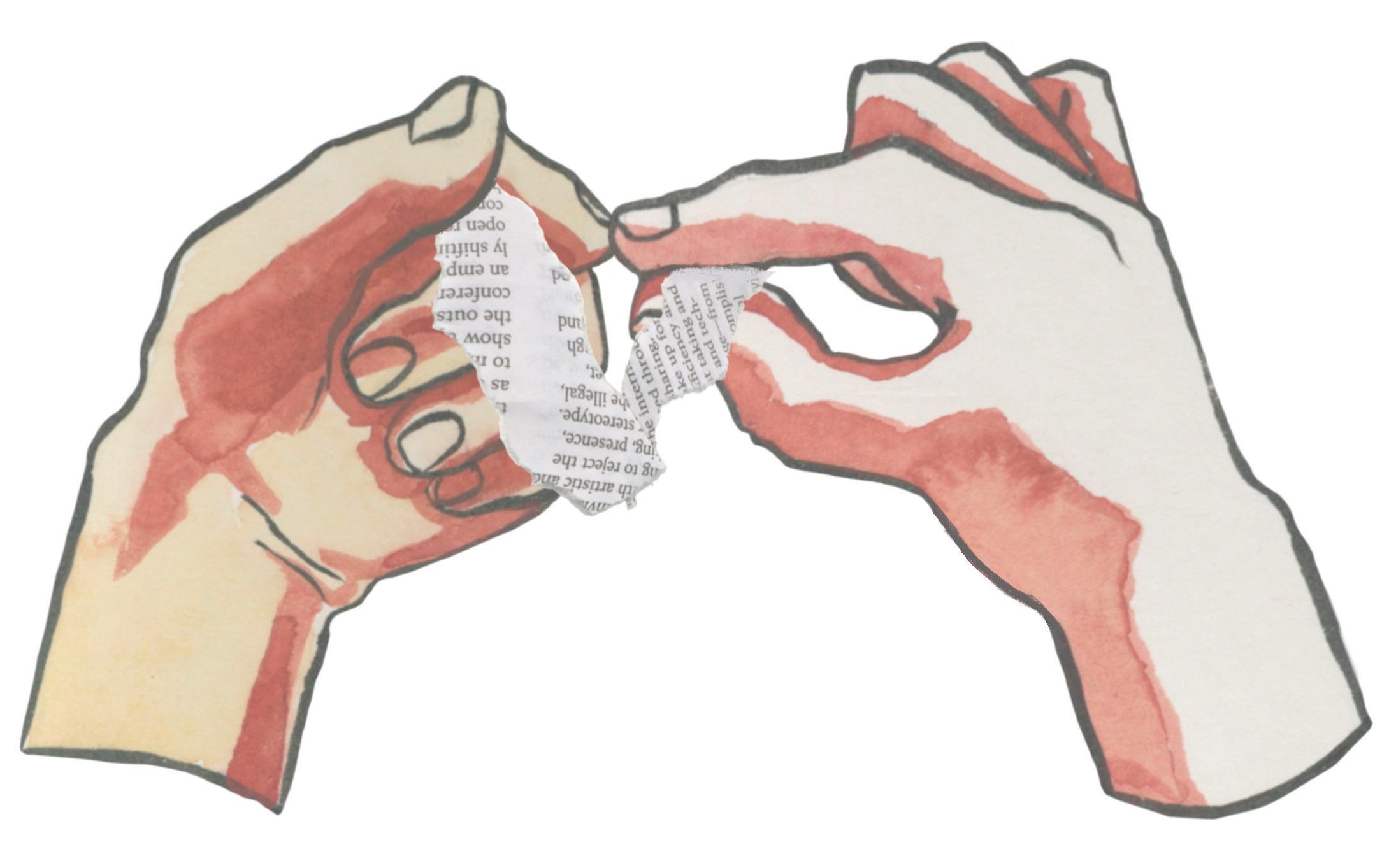
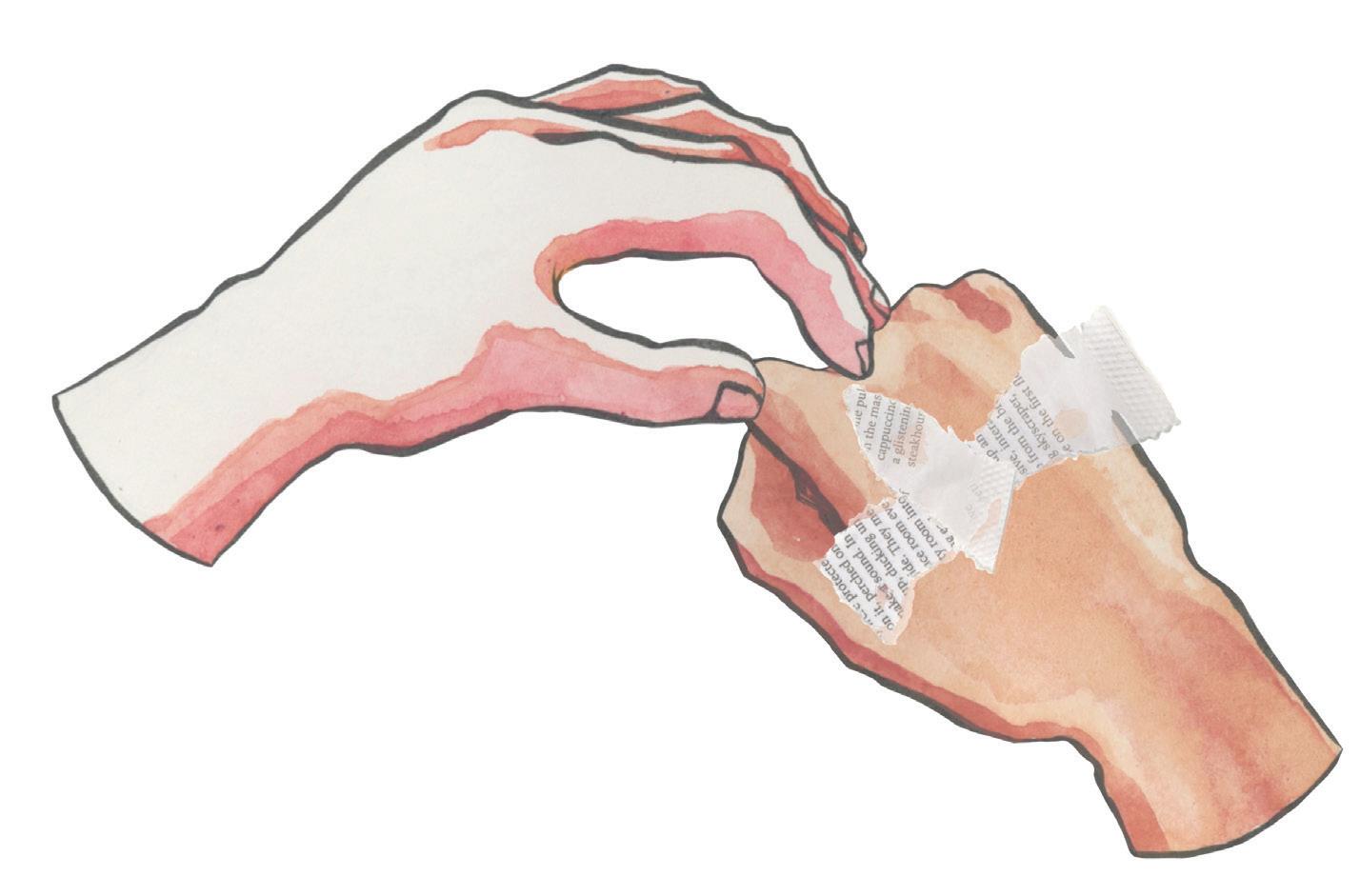

TIERRA SHERLOCK B’24 is more interested in the hands than the hammer.
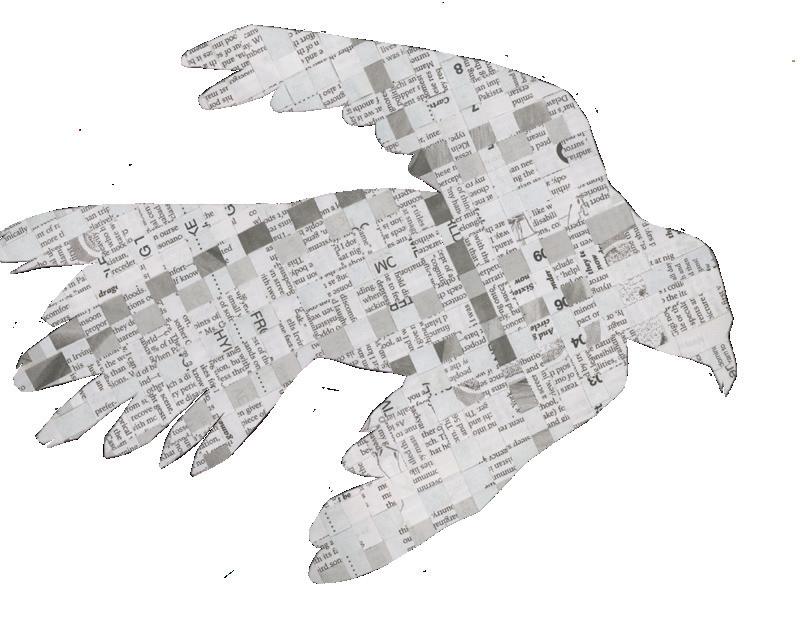
 In the style of Anne Carson’s Nox
By Faith Griffiths
In the style of Anne Carson’s Nox
By Faith Griffiths
1.1. Mid-afternoon on the beach, cold metal digging into my closed palm, I try to picture his face. I give him my nose and my father’s eyes and my grandfather’s hair. He wore glasses in the pictures I’ve seen, but I doubt he wore them that day. Not on the beach—this beach.
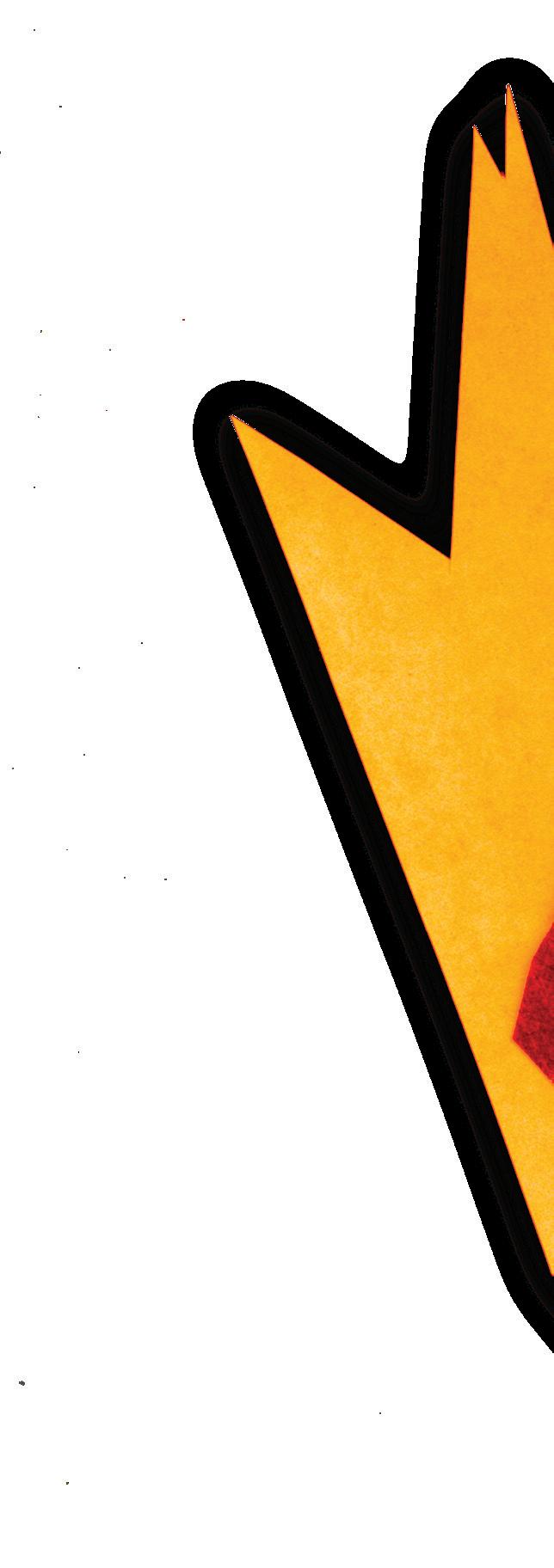
1.2. But he wore this necklace, the one I now slip over my head—a beaded aluminum chain strung with a large metal cross, the hint of rust creeping down the chain. The water reflects a glimpse of the June sun. I try to picture his face from worn photos of him and my great-grand mother on their living room couch. But I don’t try to picture his face on this beach. I don’t try to picture that day.
story historia (noun) an account of imaginary or real people and events told for entertainment. an ac count of incidents or events. anecdote (especial ly an amusing one) an account of past events in someone’s life or in the evolution of something. a widely circulated rumor (lie, falsehood, legend) romance. a statement regarding pertinent facts. imaginary facts. a truth. a statement of lies that make up truths. a person (real). a character. of short story: a fictional account, smaller than a novel. I’d like to tell you a story: the story is short. it’s real it’s real (if I remember right) it is real. the people have lived many stories. (can you live outside a story?) the stories tell of people. (do you imagine them?) a tale. a narrative. history. history (imagined).
1.3. I buy a glass jar in the museum gift shop before we walk to the shore. My knowledge of this beach is mechanical—statistics from the guided tour mixing with faded high school history lectures. Sophomore year a teacher unfurls a map and traces a path with his pointer figure. From here to here and finally landing there.

1.4. The beach holds an eerie silence, huddled tour groups whis pering around decrepit bunkers and scattered monuments. Crouching down, I fill the jar slowly—a ritual. I listen to the waves. My nail traces the outline of the cross; I trace the moments that led from him to me. From here to there and back again.
sand arena (noun) a loose granular substance, result ing from the erosion and disintegration of rocks and forming the major constituent of beaches, riverbeds, and deserts. debris. technical: sediment whose particles are larger than silt. (verb) to smooth or polish with an abrasive. to wear down, rub away. to return to the earth. grains of rocks (often quartz) a million specks on a beach—dis solving, eroded. take it with a grain of sand. pieces that remain, forever buried under waves. individu al flecks piled until their boundaries blend, spread across the beach and the bottom of old bags. a coarse permanence. of time: the moments of a life a glass jar pouring out the hours. a glass jar on the bookshelf. ghosts against a cold metal chain.
1.4. A story: before the war, he was a coal miner—they all were, for generations before me. Late in the summer of 1941, he has a baby boy (my grandfather). Then, several months later, bombs bring the war clos er to their doorstep. He enlists soon after, sets down his mining lamp and boards a boat headed to Europe. Sometime later he finds himself on a shore, surrounded by waves. Omaha. He wears a cross around his neck, and his boots dig into the sand.
1. 5. In 75 years, I will wear the same necklace, the same sand creep ing into my shoes.
mea (pronoun) that which belongs to me. used to refer to a thing or things belonging or associ ated with the speaker. when used before vowels: my (archaic). (noun) a pit or excavation in the earth from which mineral substances are extracted. a deposit. of war: a subterranean passage under an enemy position. an explosive placed in the ground or in water, set to explore when disturbed. a hid den object meant to destroy upon contact. (verb) to dig under to gain access or cause the collapse of (an enemy) undermine. to extract something from the earth. to own. to have possession of. to take possession. this earth belongs to me. the ground belonged to you. to dig, to hold the lamplight high, to make a living underground. to possess. this is mine. this cross is yours (now mine). the sand sits on my shelf. you used to carry it home in your boots, shaken on the floor. these waves are yours (and mine). this life is mine and yours.
hey bury themselves in the murky caverns of our souls. They sink their gnarled, grimy claws into the most vulnerable recesses of our minds. They emerge from the past to haunt us into the present, and they refuse to be ignored. The great artists of every generation, from Dos toevsky to Imagine Dragons*, have wrestled with them…and now it’s my turn to join the
Dear Indie, I matched with my ex on Tinder.

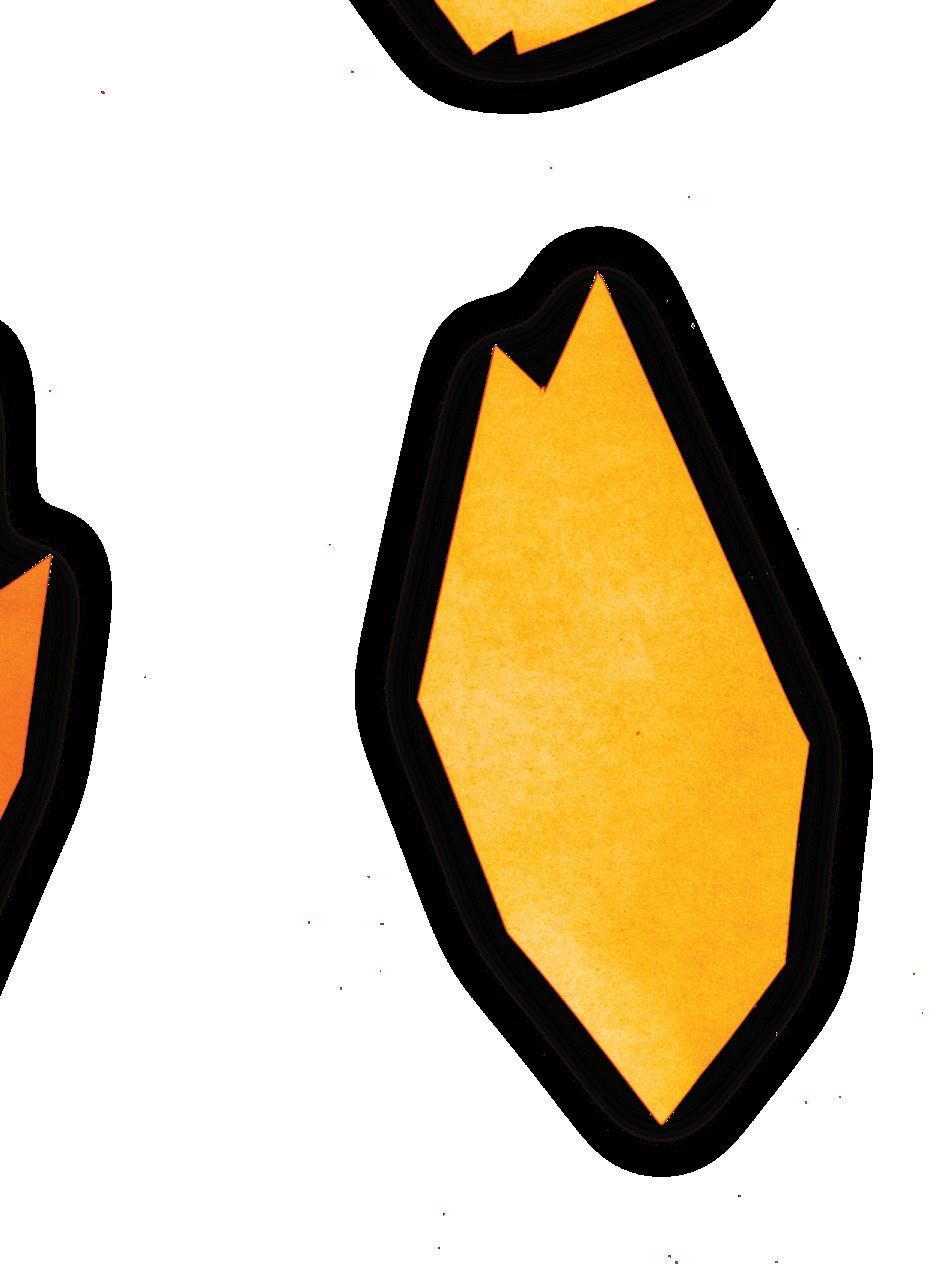
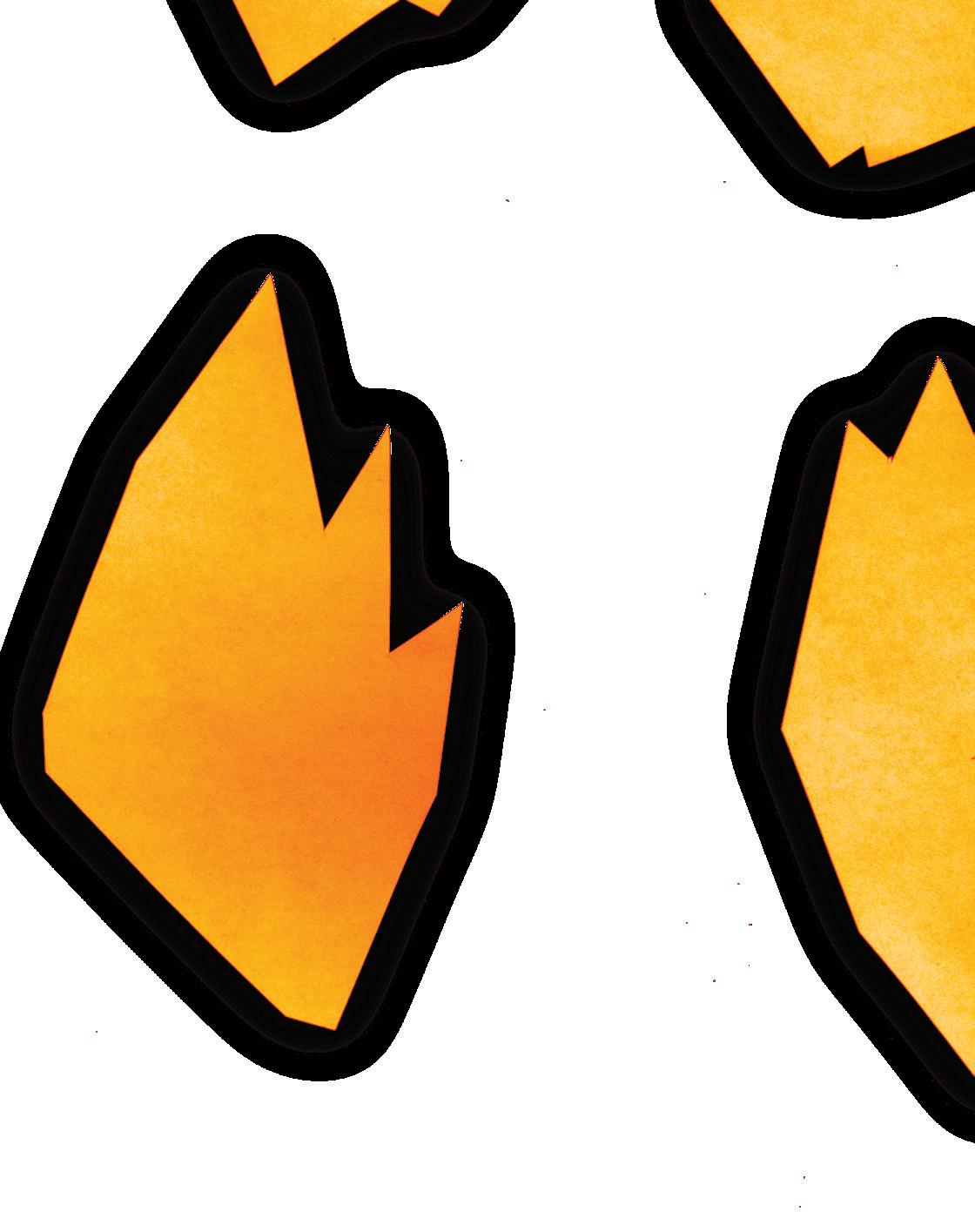
Love, Rekindling

I called my professor "mom" two weeks ago.
Love, Freudian Slip
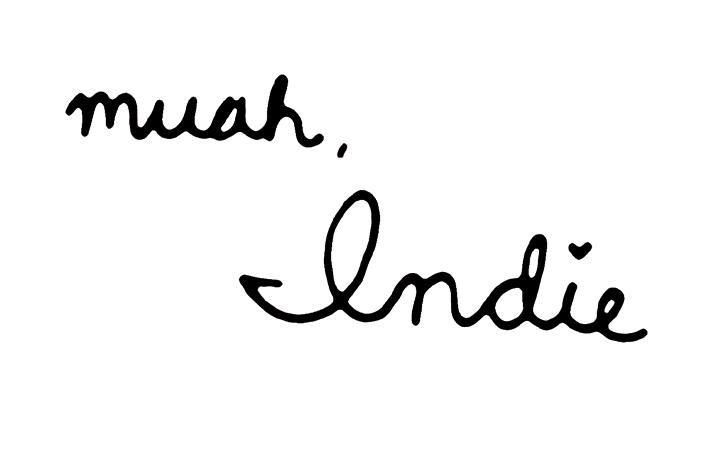
I’ll
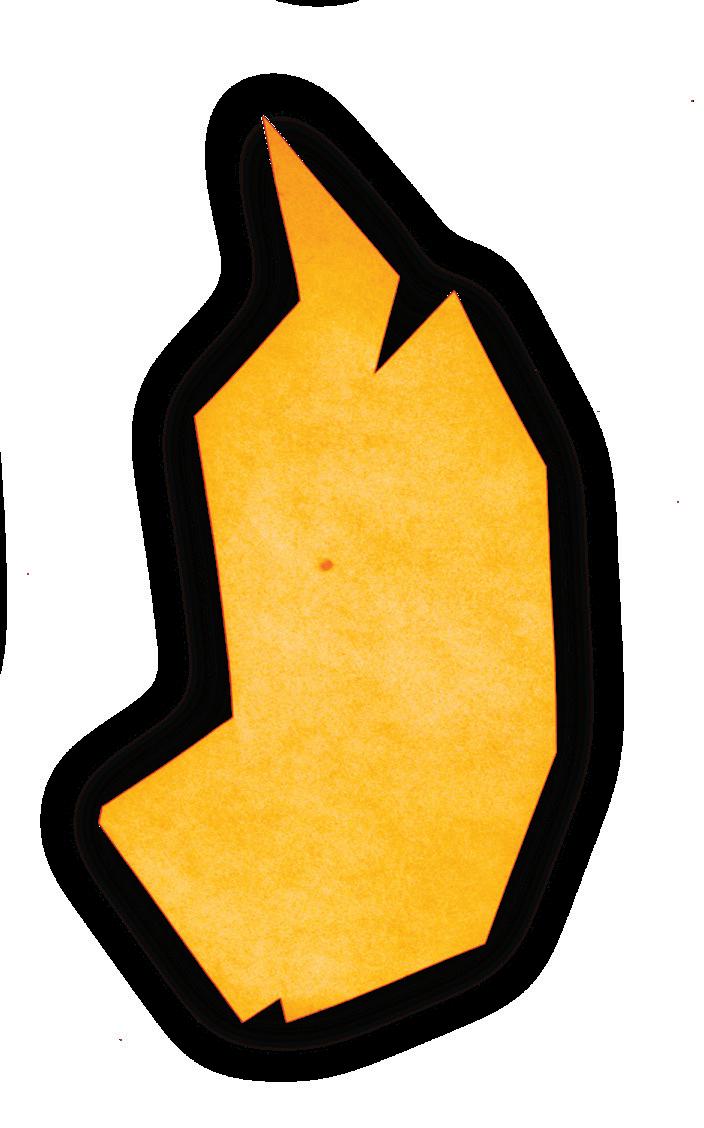


the end of
Dear Indie,
what I really want to do at Brown is theater.
With a little time management, you can make both work. If that’s too much, get your friends to hack the power in the gym so you can make it to callbacks. If that’s too much, try 24-Hour Plays?
This week, I’ll be helping you tackle your demons of all shapes and sizes, whether they’ve reappeared from the past, resur faced from the dizzying depths of your weird psyche, or just popped out of nowhere and refuse to leave you alone. There’s, like, a ton of demons I have to fight for you people, so I’m conducting highly efficient, rapid-fire exorcisms. I’m on a tight schedule because I promised my own demons I’d go hang out with them—I took some time away from wrestling them, and once I got to know them a little better, I realized they’re actually re ally cool and a lot of them have a good sense of humor, so we’re all going to Flatbread

Pitch Per-style riff-off
a basketball
but,
*Taylor Swift, too, if you count "Haunted."
Saturday 10/29 @ 12PM: Climate Protest: Solidarity with the People of Pakistan
Join Climate Action RI and the Jewish Youth Climate Movement of RI at this protest to hold Chase Bank accountable for profiting from the fossil fuels that exacerbate the climate crisis and historic flooding in Pakistan.
Location: 291 Thayer St, Providence, RI 02906
Monday 10/31 @ 8AM: Protest Action for Housing Shelters/Sites
Show up to protest and put pressure on Housing Secretary Josh Saal and Governor Dan McKee to open up new housing spaces as winter approaches.
Location: Smith St Side of the State House, 82 Smith St, Providence, RI 02903
Tuesday 11/1 @11AM-1PM: Popcorn with the Peer Counselors
Sponsored by The Minority Peer Counselors (MPCs), Women, Gender and Sexuality Peer Counselors (WGSPCs) and U-FLi Peer Counselors (U-FLiPCs), pop by for some gourmet popcorn and to learn about upcoming peer counselor programs.
Location: Main Green, 75 Waterman St, Providence, RI 02906
Tuesday 11/2 @ 4:30-6:30PM: Providence Youth Student Movement (PrYSM) Organizing Circle Orientation
Are you community rights-minded? Attend Providence Youth Student Movement’s youth leadership program to learn about grassroots orga nizing, abolition, leadership, and more! Reserve your spot at bit.ly/ ocworkshopsform.
Location: 807 Broad Street Room 430, Providence RI 02907
Wednesday 11/2 @ 4:30PM Counselors Not Cops 101
Interested in activism? Passionate about education justice? Join the Providence Alliance for Student Safety at their Fall kick-off event to learn more about the push to replace cops with counselors in Providence schools. RSVP at bit.ly/CNC_10.
Location: Providence Student Union, 769 Westminster Street, Providence, RI 02903
Thursday 11/3 @ 4PM: Community Rally! Save Morely Field
The Pawtucket City Council and Mayor Donald R. Grebien have moved to destroy the single green space in District 5’s only recreational greenspace. Attend this rally to denounce the action.
Location: Pawtucket City Hall, 137 Roosevelt Avenue, Pawtucket, RI 02860
Friday 11/4 @ 10:30PM-1AM: Adult Skate Night - 90’s R&B Music
Grab some friends and skate to some 90’s R&B music. Laser tag and rock climbing are also available for $5 per person per game. Tickets start at $20—which include rollerskate rental—and can be purchased on Eventbrite at tinyurl.com/adult-skate-night.
Location: United Skates of America, 75 New Road, East Providence, RI 02916
Do you have an event, action, or other information for the Providence community that you’d like to see shared on this page? Email us at indybulletinboard@gmail.com!


All Day until December 22nd: Art Exhibition: Perceptions of Organizational Change, through a Kaleidoscopic Lexicon of Color Jazzmen Lee-Johnson and Deborah Spears Moorehead, two Rhode Islandbased artists, have created site-specific artworks that respond to the Center for Public Humanities’ historic wallpaper, Les Vues d’Amérique du Nord, which features false depictions of Indigenous people.
Location: Main Hall in the Nightingale-Brown House, 357 Benefit St, Providence, RI 02903
Saturday 10/29 @ 2:30-3:30PM: Halloween Agar Agar Plastic Workshop
Brown-RISD Innovation Community invites Brown and RISD students to participate in a sustainable workshop to make bioplastic candy wrappers with agar agar! You can RSVP using the Google Form that can be found in their Instagram bio @brownrisdinnovation.
Location: Ewing Multicultural Center, 41 Waterman St, Providence, RI 02906
Sunday 10/30 @ 1-6PM: Wigs and Waffles: Halloween Drag Brunch
Attend an unforgettable brunch experience at Wigs and Waffles, which will feature drag queen performances while you enjoy delicious food.
General admission tickets cost $15 and can be bought on Eventbrite at tinyurl.com/wigs-and-waffle-brunch.
Location: Mangos Restaurant & Catering, 15 Exchange Street, Pawtucket, RI 02860
Saturday 11/19 @ 2:30-4:30PM: Collaborative Zine Workshop
Zines are an empowering medium where artists and writers find expres sion and community outside of mainstream publishing. For this work shop, engage with What Cheer Writers Club and local artist Zooey Kim Conner at Binch Press / Queer.Archive to learn about how zines can be used as a tool for knowledge sharing, participate in drawing and writing exercises, and learn the basics of zine assembly and binding. Participants will also get to take home a copy of What Cheer Writers Club’s collabo ratively designed zine. Reserve a free spot on Eventbrite at tinyurl.com/ collaborative-zine-workshop.
Location: Binch Press / Queer.Archive.Work, 400 Harris Ave Unit F, Providence, RI 02909
Mutual Aid* & Community Fundraisers
*Mutual aid is “survival pending on revolution,” as described by the Black Panthers. Join in redistributing wealth to create an ecosystem of care in response to a system of institutions that have failed or harmed our communities.
+ Donations needed for a Housing Activist
Donate at tinyurl.com/donate-2-hope Housing Opportunities for People Everywhere (HOPE) at Brown is organizing this GoFundMe for a fellow housing activist. This friend of HOPE’s is facing eviction and recently lost his job and had to pay for eye surgery. Donate to help him out of this stressful situation.
+ #GiveForDV
Donate at givefordv.nnedv.org/ GiveForDV strives to raise awareness, increase donations and volunteer efforts, and deepen community engagement around domestic violence. Donate to help support survivors.
+ Black and Pink Providence’s Fundraiser for Tunji
Donate at tinyurl.com/help-tunji
Black and Pink Providence, a non-profit organization working towards prison abolition, is raising money through a GoFundMe for Tunji. Tunji is formerly incarcerated and recently lost his job. You can help him get back on his feet by going to the Black and Pink Providence’s website to donate.
+ Amenity Aid Rhode Island
Donate at amenityaid.org/donate-money
Amenity Aid works to provide hygiene resources to marginalized communities and low-income people in need. On top of serving individuals, Amenity Aid part ners with local shelters, food pantries, anti-domestic violence organizations, and other community groups who support underserved communities to distribute hygiene resources.
+ Project LETS Providence COVID-19 Relief Fund
Donate at projectlets.org/covid19
Project Let’s Erase The Stigma (LETS) is working in coalition with various grassroots organizations in Rhode Island to support marginalized groups in our community in the wake of the COVID-19 pandemic. All donations will directly help individuals, children, and families meet their basic needs.
+ Ocean State A$$ Mutual Aid Fund
Donate at tinyurl.com/oceanstateass
Support sex workers statewide. Priority given to BIPOC sex workers, trans sex workers, and sex workers who have been impacted by the pandemic.
+ Queer & Trans Mutual Aid Providence
Venmo: @qtmapvd; Paypal: qtma.pvd@gmail.com / Info: tinyurl. com/qtma-pvd
QTMA PVD is a small, volunteer-run mutual aid fund for queer and trans folks in the Providence, RI area. They do payouts once per week and have distributed over $80,000 since their founding in June 2020. They currently have over 30 outstanding requests for aid and would appreciate any donations!